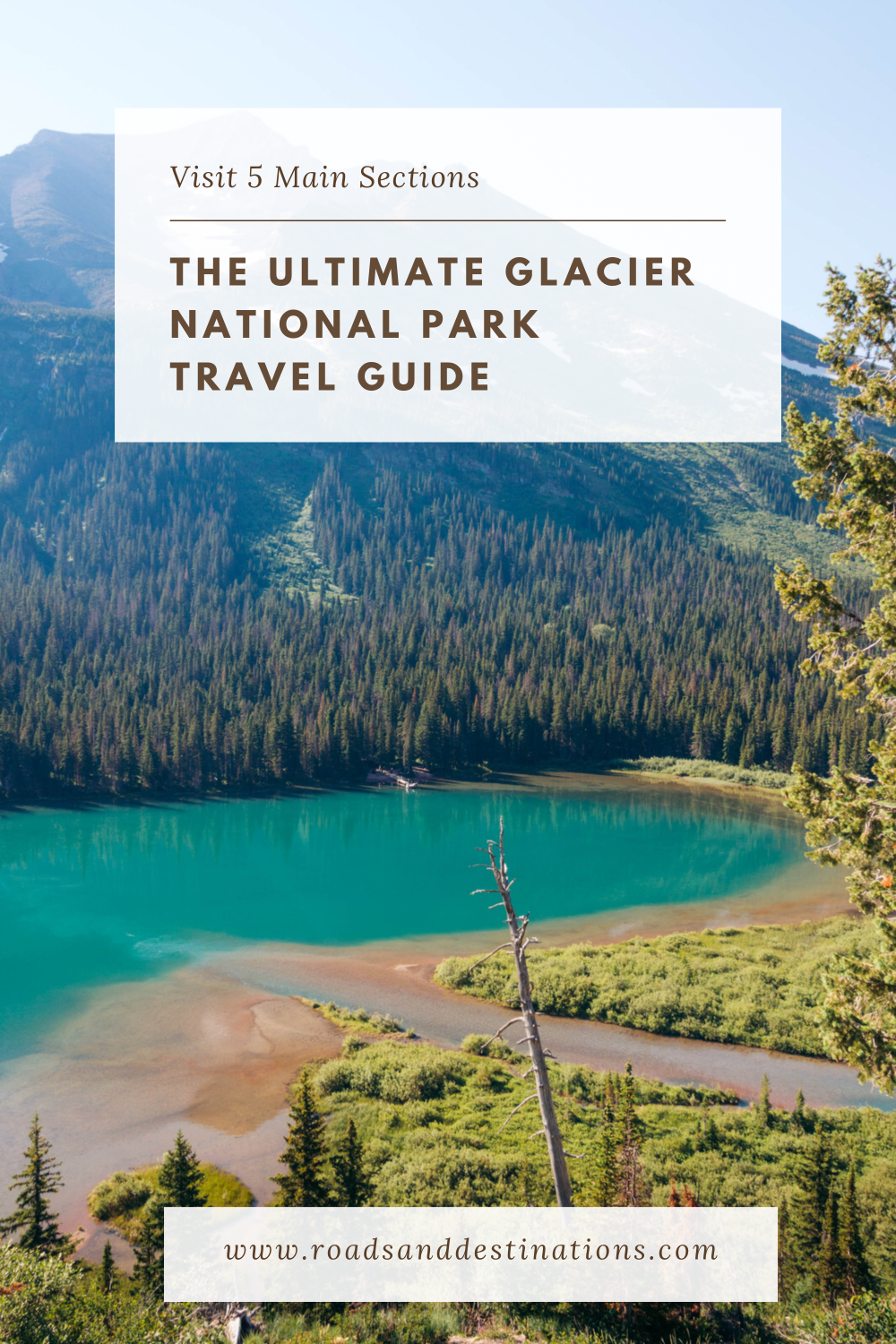Glacier National Park is one of the most beautiful national parks on the West Coast of the U.S. It’s huge, diverse, and absolutely breathtaking. In this Glacier National Park guide, you’ll learn everything about how to visit, get around, and the best things to do in this dramatic paradise in Montana.
Last updated: April 7, 2025
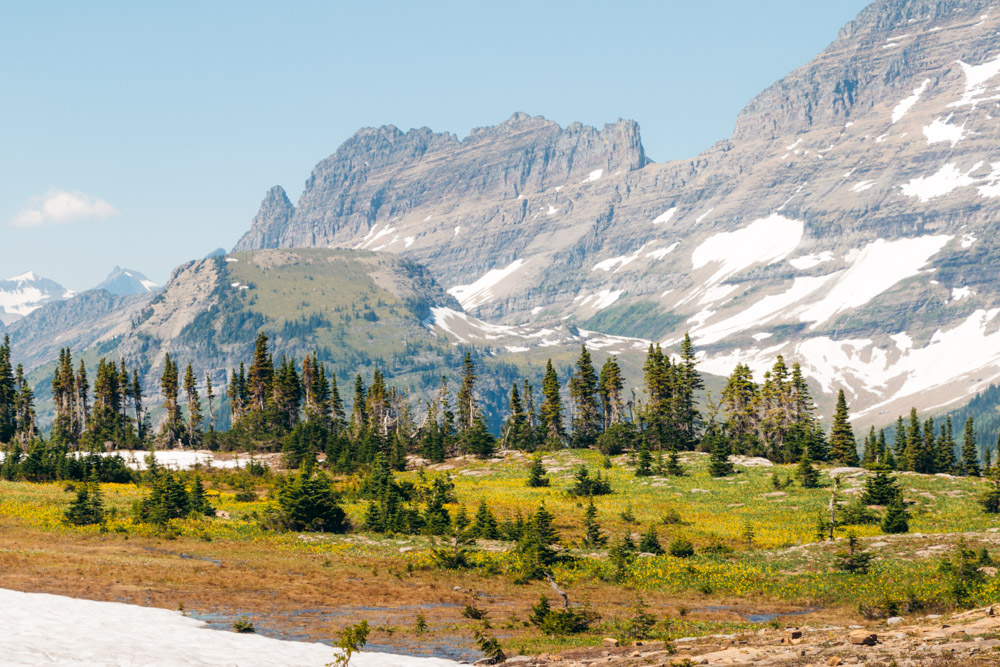
The Ultimate Glacier National Park Travel Guide: Tips, Map, and Everything You Need to Know before You Visit
Located in the northwestern corner of Montana, Glacier National Park is one of the most beautiful places to visit in the USA. From sweeping hills, roaring waterfalls, and glaciers towering in the distance, the place is an outdoor adventurer’s dream come true.
Spreading for miles on end, this remote area resembles the rolling hills of Switzerland, so vividly praised in bountiful movies and novels. The similarities become even more profound as you visit different sections of Glacier National Park.
The greatest example here is the astounding Many Glacier area, which many claim to be the most beautiful corner to visit in the park. Home to scenic lakes and abundant Glacier wildlife, it harbors the popular Many Glacier Hotel. The iconic lodge was built in 1915 in the finest Swiss architectural traditions.
One of the most cherished historic structures on the West Coast, the Many Glacier Hotel is located along the east shore of Swiftcurrent Lake and is a central place of every Glacier National Park travel guide. And there’s certainly a reason for it. Adding a human touch to the unmatched natural surroundings, it’s one of the best and, yes, scarce places to eat and rest within the park.
What Can You Find in this Glacier National Park Travel Guide
Since we came so close to discussing the content of this blog post, there is what you can expect to find here. This complete Glacier National Park travel guide takes you to the epic Going-to-the-Sun Road. Later, it introduces to you some of the photogenic lakes and valleys in Many Glacier and sets you off on the unforgettable hiking adventures.
Along the way, you’ll discover some of the best places to see abundant Montana’s wildlife.
Other topics – maybe not the most exciting, but surely important – in this Glacier National Park guide include logistic matters such as how to get around, where to stay, whether you need a self-guided or guided tour of the park.
And I don’t know about you, but knowing the history of a place you visit – in our case Glacier – is as important as getting familiar with its present. So a short story of the Glacier National Park’s past has made its way into this travel guide as well. Although you can skip it, if you need to.
Without further ado, here is the ultimate Glacier National Park travel guide to help you plan your trip.
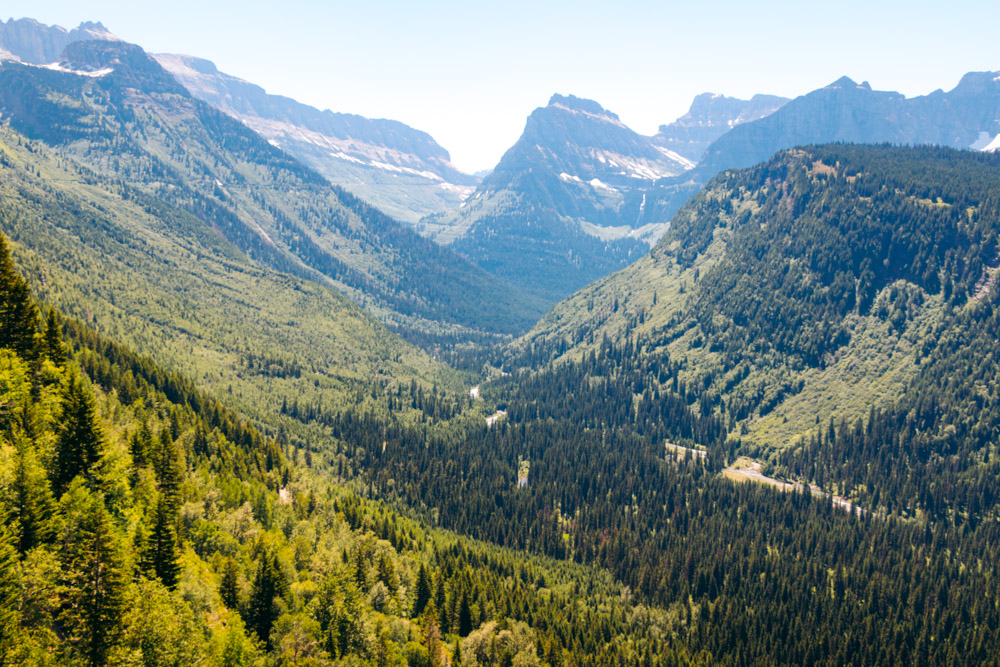
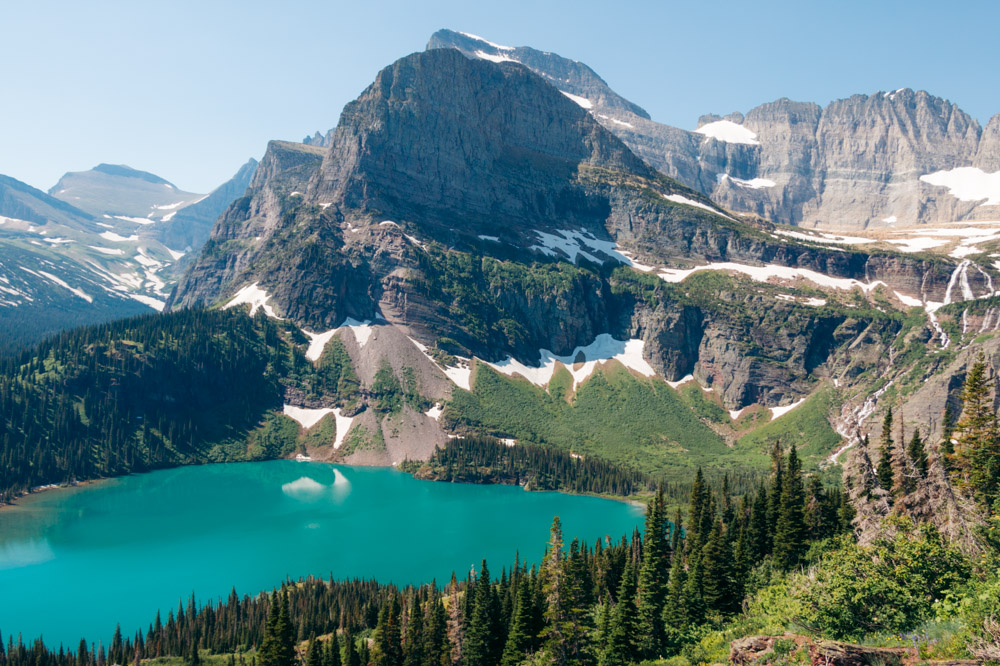
Glacier National Park Travel Guide: Fast Facts
- Established: May 11, 1910
- Size: 1,583 square miles (4,101 square km)
- Location: Montana
- Annual Visitors: 2-3 millions (varies yearly)
- Fact: America’s 10th national park
- Part of: Waterton-Glacier International Peace Park, World Heritage Site
Glacier National Park Travel Guide: History in a Nutshell
Despite its harsh weather conditions most of the year, Glacier National Park has enticed people for centuries. The earliest human presence in the northern part of Montana dates back to over 10,000 years.
As the old records indicate, several different tribes, such as the Blackfeet Indians, the Salish, and Kootenai Indians, had long adapted to the unfriendly environment. Picking edible plants and berries in summer and hunting buffalos had helped the first permanent residents survive and thrive in the area long before Europeans arrived.
The representatives of, as it was known back then, “civilized” world flocked to northwestern Montana much later. Their travel excursions, however, were rarely focused on the natural beauty of the Glacier National Park area. Instead, beavers and other pelts were the reasons for their visits. Shortly after, miners and later settlers looking for land to live and work on followed the hunters’s lead and moved to Montana.
Creation of the Park
Completion of the Great Northern Railway in 1891 allowed even more people to travel to the today’s Glacier National Park area. With the newly-introduced ease of getting to and from the remote northwestern Montana, homesteading started to flourish.
When the pioneers finally settled into a routine and less effort was spent on mere survival, more and more people recognized the unprecedented beauty of the area. One of such nature enthusiasts was George Bird Grinnell. A zealous advocate of northwestern Montana, he strived to preserve the area in its untouched conditions. Finally, on May 11, 1910, President Taft signed the bill, recognizing Glacier as America’s 10th national park.
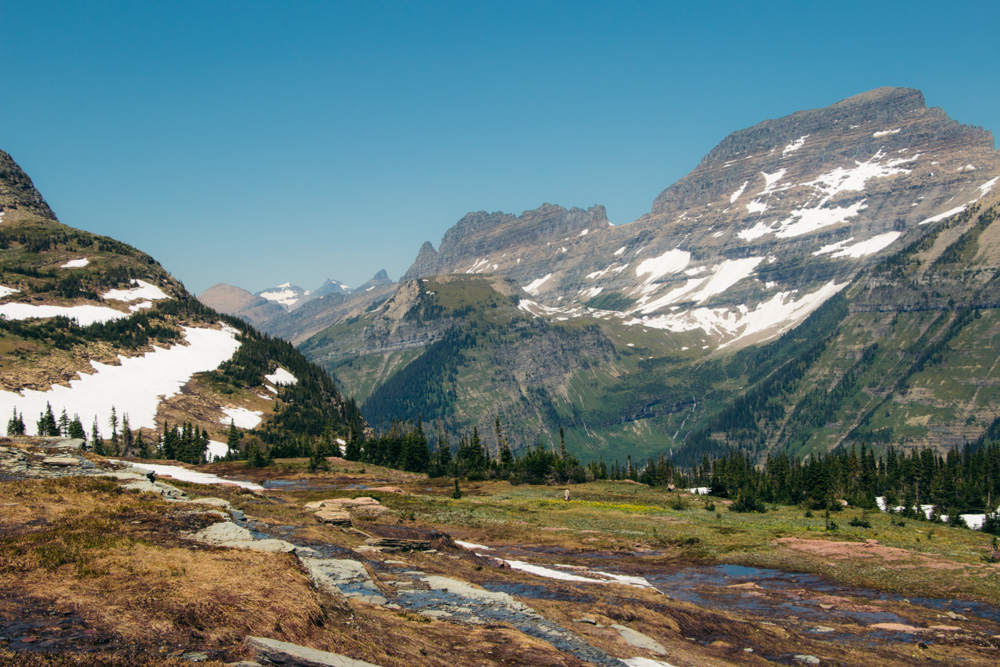
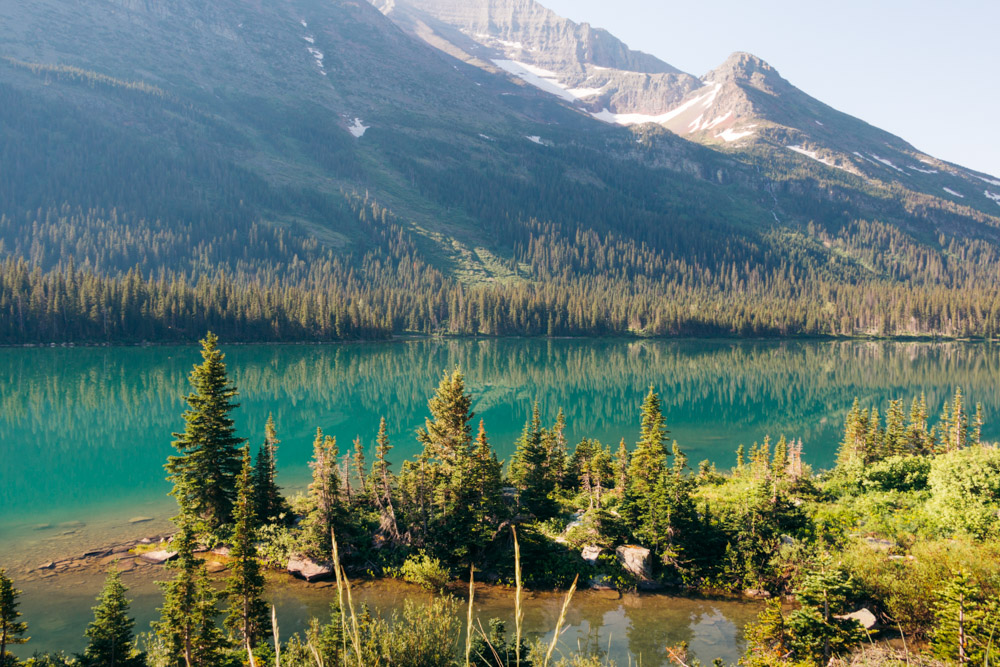
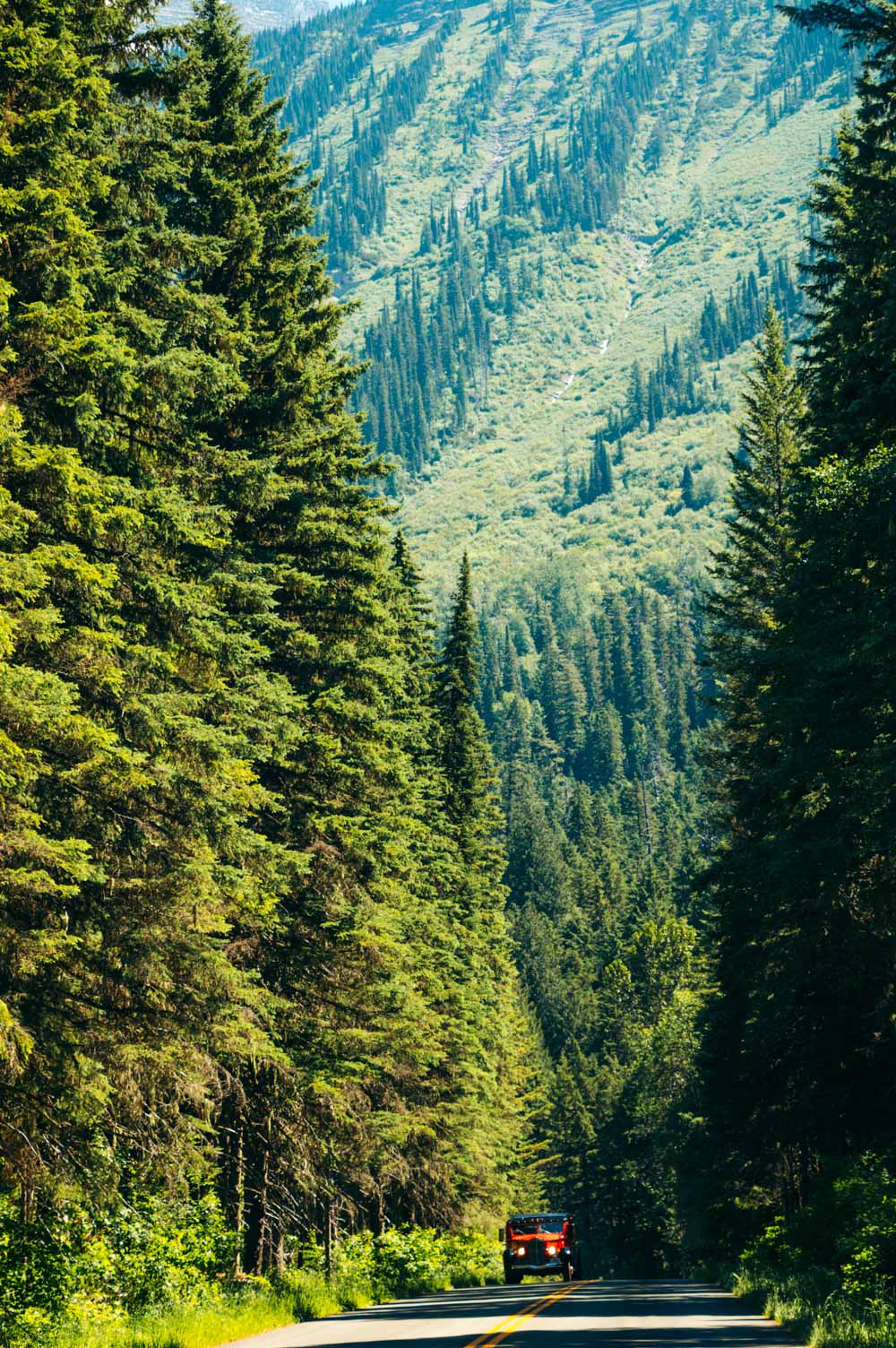
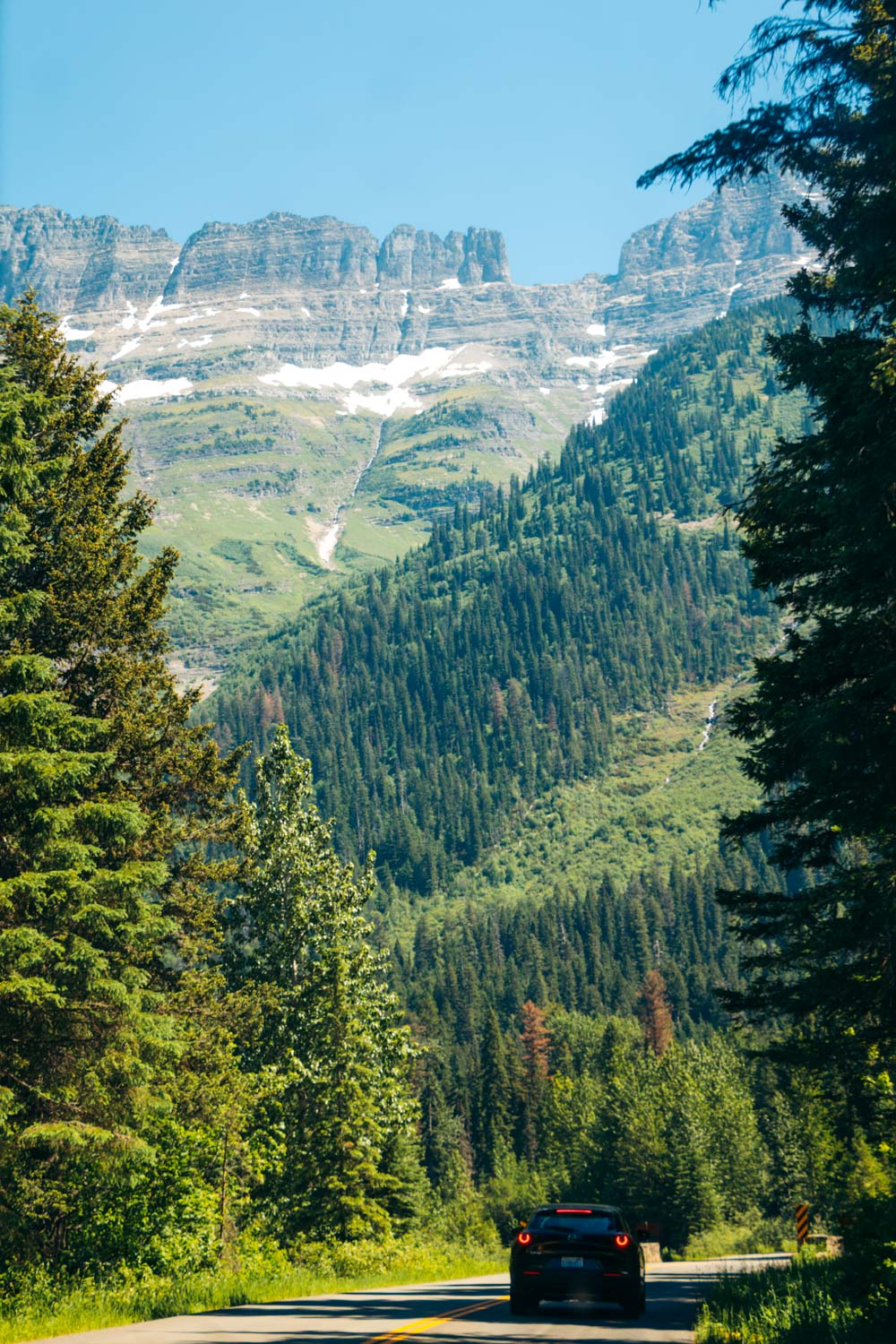
A Complete Guide to Getting Around Glacier National Park
Driving is the best way to visit Glacier National Park and travel to its most secluded areas. Parking in Many Glacier and along the scenic, yet overcrowded Going-to-the-Sun Road, however, is not a piece of cake. To eliminate this issue, the park offers several options on how to get around. Let’s start with the most popular and later add alternative ways on how to visit favorite and secluded areas of Glacier National Park.
1. Visit Glacier National Park by Car
You can’t deny the convenience of having a car and visiting different sections of Glacier National Park on your own terms. Driving is also the only option if you long to explore lesser-visited sections such as Two Medicine, the North Fork, or Goat Haunt. Thinking about crossing the border and exploring U.S. and Canada’s national parks on the same road trip? Then you definitely need a car.
TIP: Yet keep in mind that many roads within Glacier and some roads outside the national park are seasonal. Several areas of the park are inaccessible most of the year. So, be sure to check road status updates frequently if you travel to Glacier National Park in fall, winter, or spring.
Parking in Glacier National Park
Parking seems to always be an issue in Glacier. In summer, parking lots near popular places often fill up by late morning or early afternoon. Let’s say, if you’re planning to visit Avalanche Lake in the late morning and travel to Logan Pass or Many Glacier around noon, you’re too late. Once the parking lot is full, park’s staff turn away all other vehicles.
TIP: To avoid being left behind, try to travel to and within Glacier National Park early in the morning and skip summer weekends and holidays if possible.
Travel within Glacier National Park: Vehicle Reservation
During the summer season of 2024, you need a vehicle reservation to enter three sections of Glacier National Park. These areas include the Going-to-the-Sun Road, Many Glacier, and North Fork. On top of park’s pass, vehicles must have a separate entry ticket for each of these sections. The reservations are limited and valid for one day. You can make your reservation only online at recreation.gov.
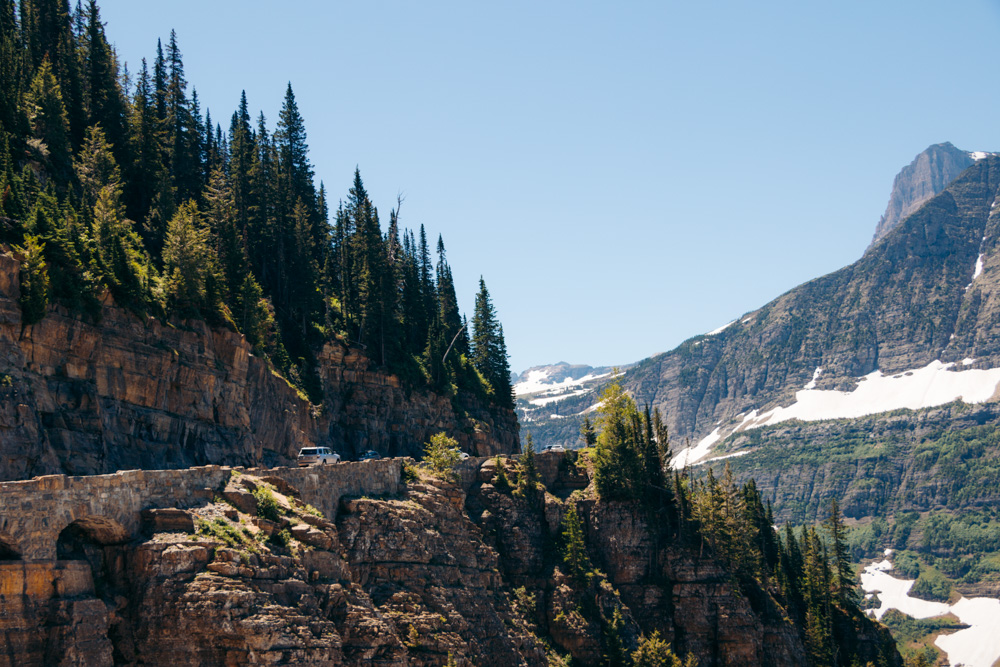
2. Visit Glacier National Park by Park’s Shuttle
To further avoid congestion and eliminate the parking issue, Glacier National Park offers complimentary shuttle services. The buses travel along the Going-to-the-Sun Road in Glacier from July 1 (or when the scenic drive opens) through Labor Day weekend on a first-come, first-served basis.
During this time, the shuttles operate daily. The first bus of the day departs from the Apgar Visitor Center (West Glacier) and the St. Mary Visitor Center (East Glacier) at 7:00 a.m. The last shuttle travels from the Logan Pass Visitor Center to the above-mentioned destinations in West and East Glacier at 7:00 p.m.
3. Visit Glacier National Park by Hiker-Biker Shuttle
The hiker-biker shuttles are a temporary option to travel within a specific section of Glacier National Park. These buses operate on a first-come, first-served basis and are offered on weekends only from May 11 until June 30 or until the day the Going-to-the-Sun Road opens for the season.
4. Visit Glacier National Park: Guided Tours
Glacier with Red Bus Tours
The historic Red Buses travel along the Going-to-the-Sun Road in both East and West Glacier. Each interpretive tour lasts 4 hours, entertaining its guests with the park’s history and favorite natural landmarks.
Glacier with Blackfeet Perspective
The Blackfeet Perspective offers a wider range of interpretive tours that lasts from half day to full day. Custom tours are also available. The buses travel along the Glacier National Park’s Going-to-the-Sun Road and throughout the land of the Blackfeet Nation.
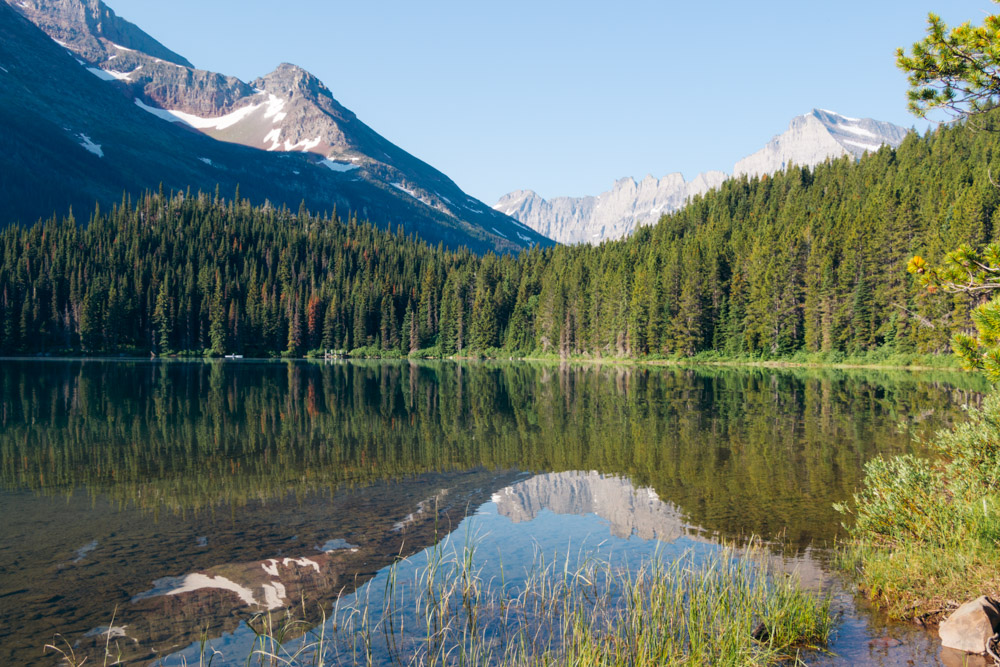
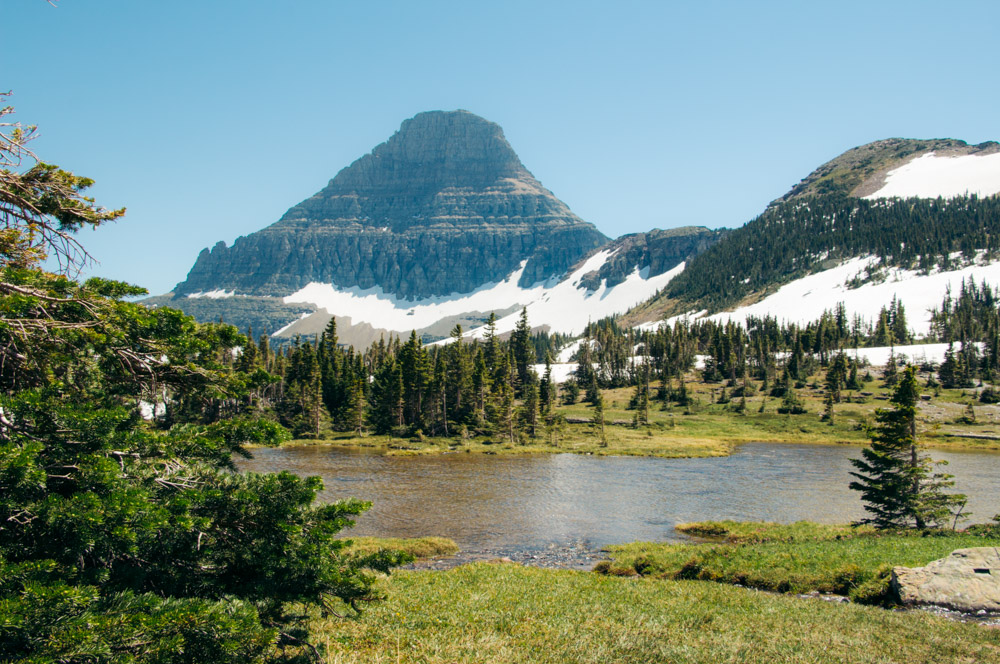
Glacier National Park Travel Guide: When to Visit
With the prolonged road closures due to the unfavorable weather conditions, you can’t help but put Glacier National Park into the category of seasonal parks. Yet unlike Yellowstone National Park, Montana’s favorite attraction welcomes travelers all year round. The alpine areas of Glacier, however, are open only during the summer season.
READ MORE: The Best Time to Visit Glacier National Park: Seasonal Activities
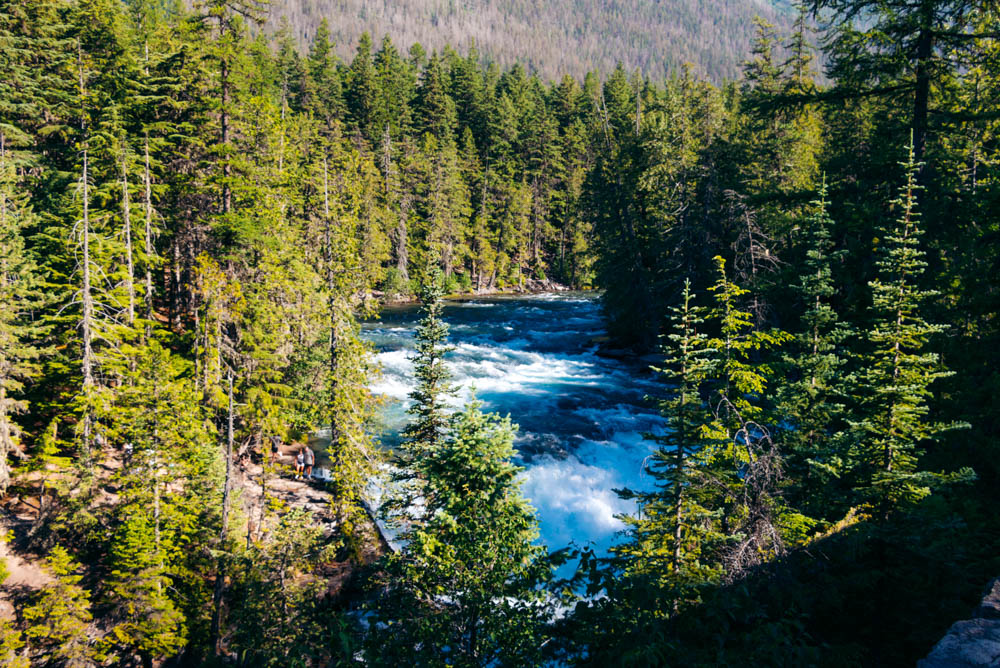
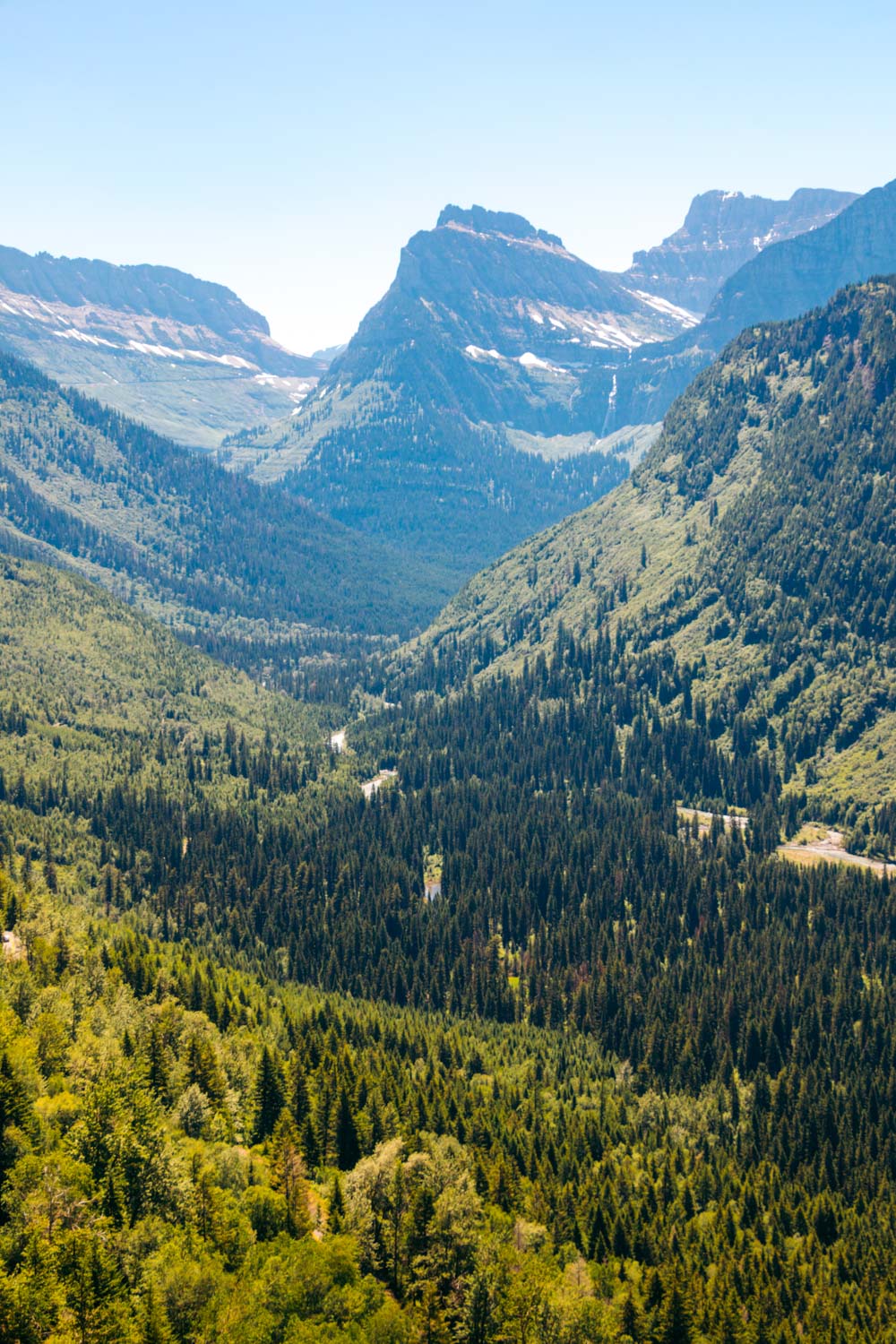
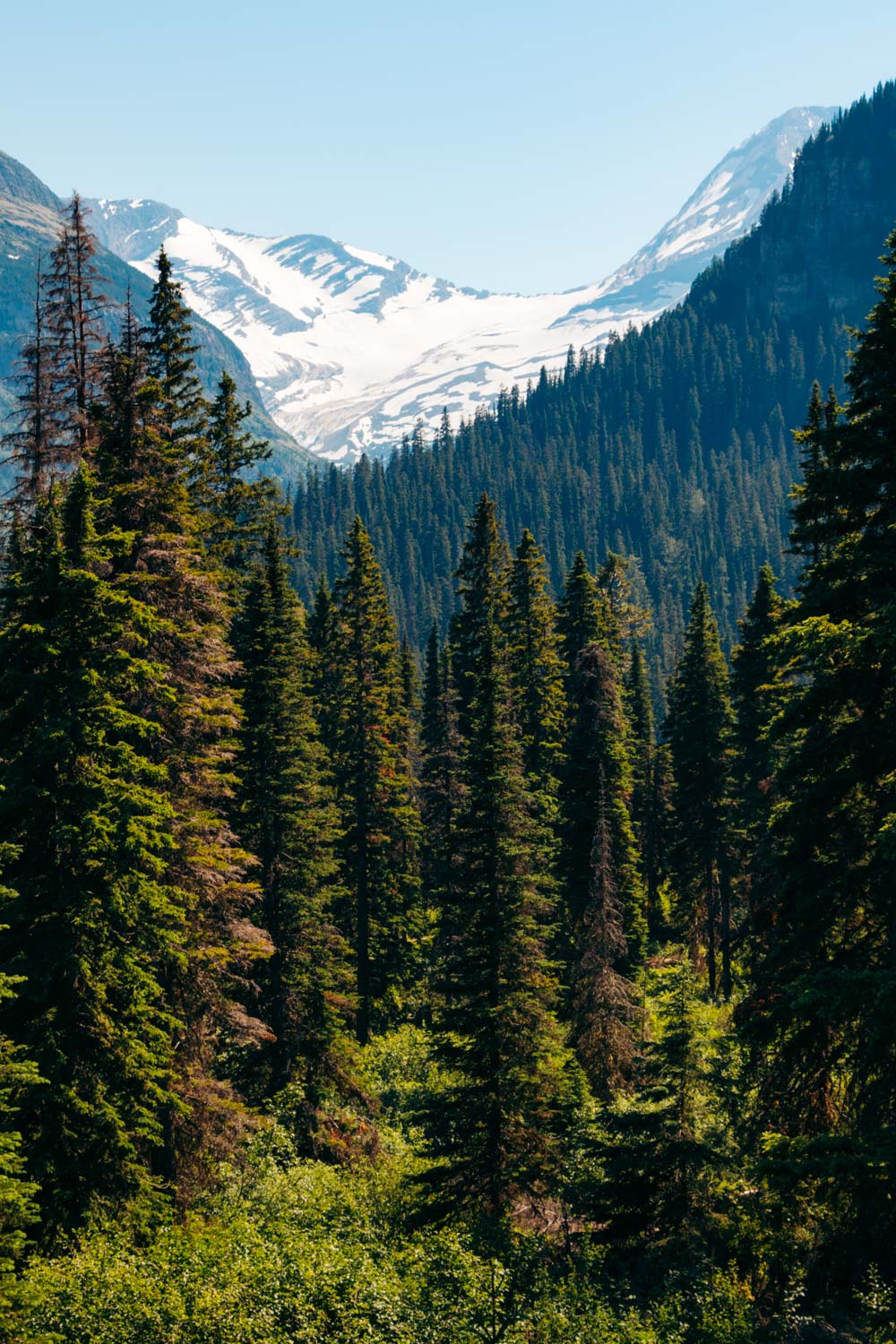
THE BEST THINGS TO DO IN GLACIER NATIONAL PARK
Glacier National Park is unique in a sense that you can find something to do and see anywhere in the park. Whether you drive along the Going-to-the-Sun Road or visit secluded corners of Many Glacier or Two Medicine, the park promises a plethora of unforgettable experiences and tons of photo opportunities. To get more specific on what to expect from the area, here are some of the best places to visit and epic things to do in Glacier National Park.
1. Visit Lake McDonald, the Largest Lake in Glacier National Park
Lake McDonald is the largest water body within the park. Stretching along the west side of the Going-to-the-Sun Road, it encompasses a myriad of scenic trails, astounds with some of the best views, and entertains with its secluded coves and scenic boat rides.
2. Hike Trail of the Cedars
The Trail of the Cedars is indeed a special place to visit in West Glacier. Famous for its tall cedars clustering closely to each other, it reminds of Sequoia National Park. Yet the walk through the old-growth forest along the 0.7-mile loop is only part of the attraction.
The highlight of this short trail is Avalanche Gorge. Adorned with fern and mosses, it serves as a temporary haven for roaring waters of Avalanche Creek before they rush under a wooden footbridge and stream farther down the hill.
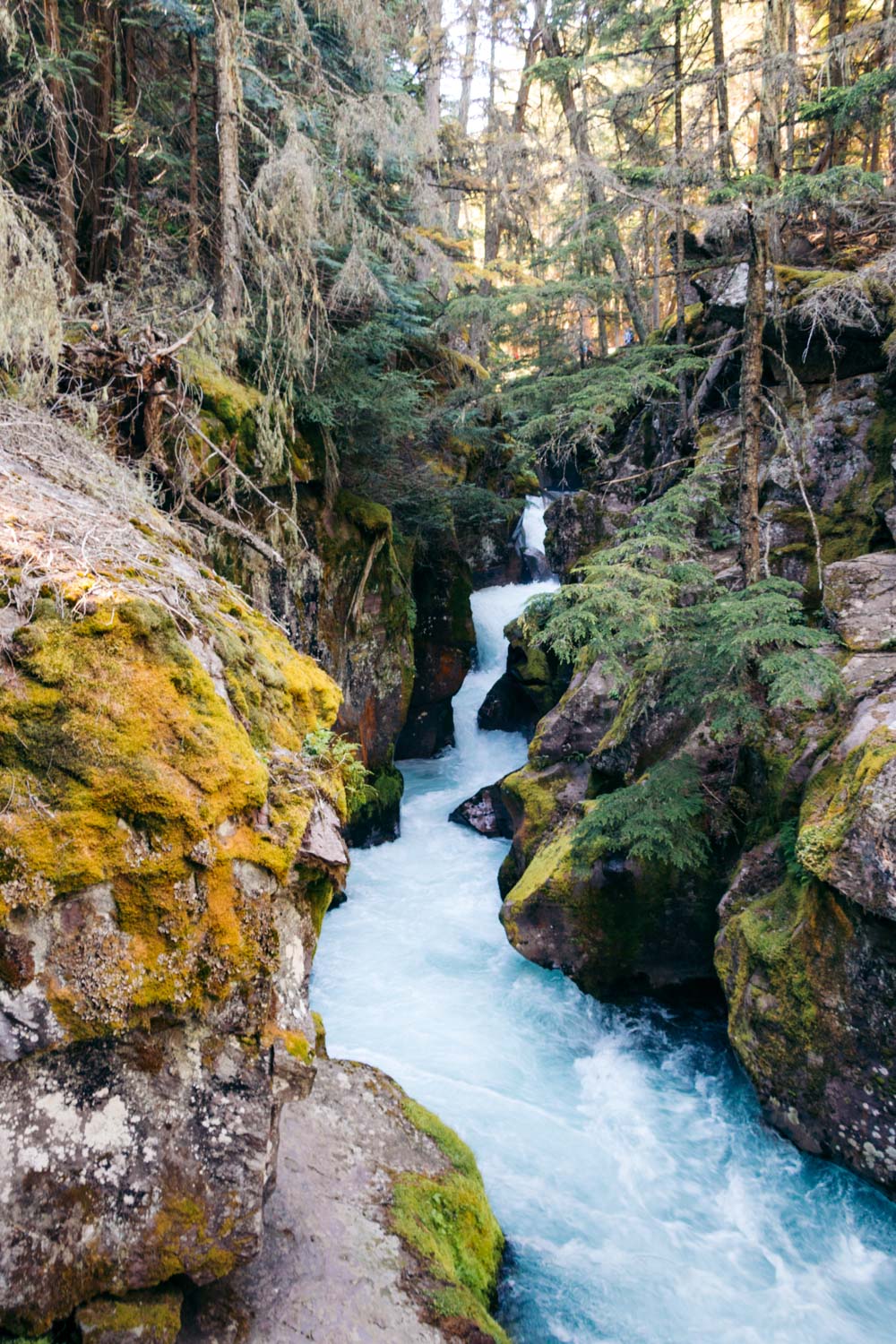
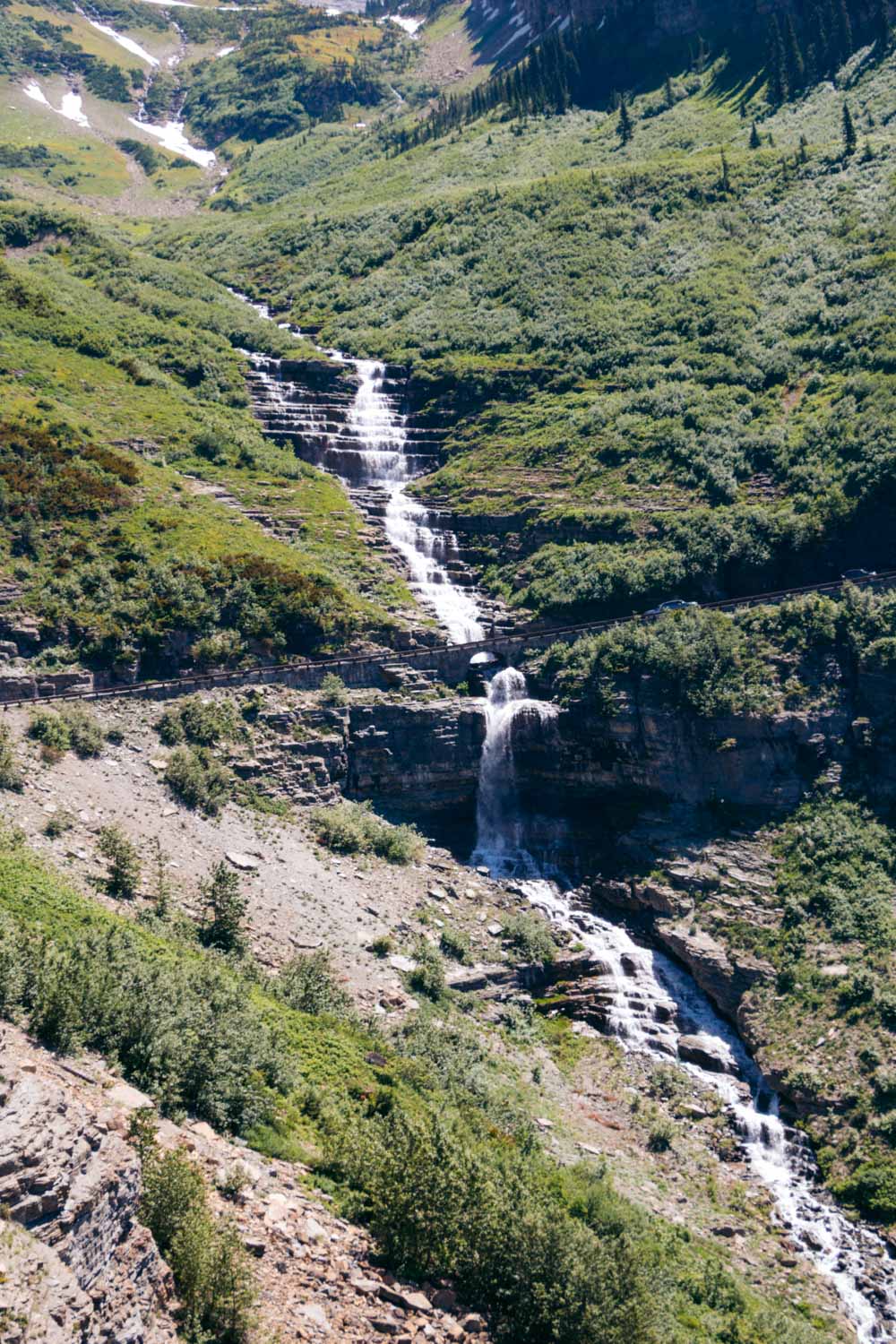
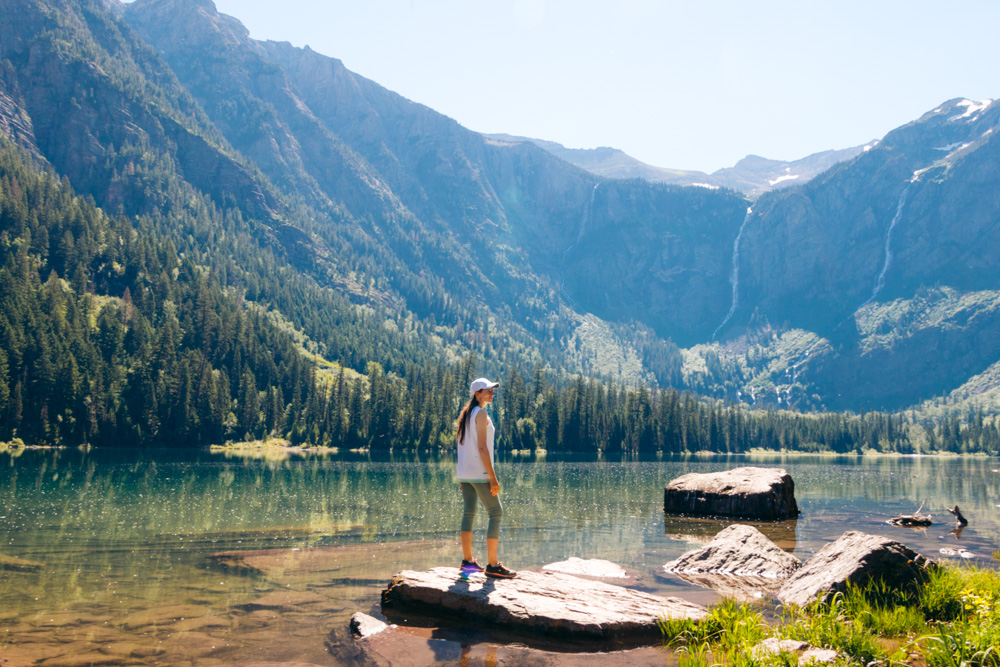
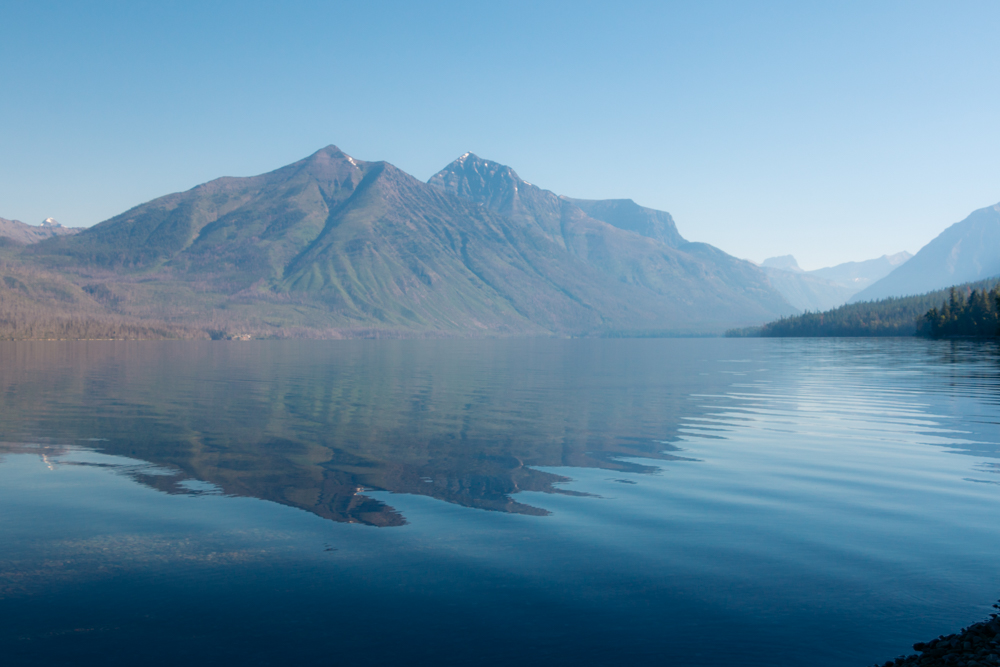
3. Visit Avalanche Lake, one of the Highlights of Glacier National Park
As you hike farther along the Trail of the Cedars, a well-trodden path forks to the left. 2 miles later, it reaches Avalanche Lake, one of the most gorgeous places to visit in Glacier National Park in the summer.
4. Take a Boat Tour
If hiking is not your cup of tea, explore the aquamarine lakes of Glacier National Park from a deck of the boat. Some of the best places suited for this type of activity include Swiftcurrent Lake in Many Glacier and St. Mary Lake at Rising Sun.
5. Fall in Love with Logan Pass
Whether you are an avid hiker who can’t wait to tread along the scenic trails or a keen animal lover, Logan Pass is a perfect place to visit in Glacier National Park.
The highest point in the Going-to-the-Sun Road corridor, it has long been a favorite of landscape photographers. Brimming with yellow wildflowers with the snowy mountains and occasional mountain goats and bighorn sheep in the background, Logan Pass is the epitome of the park’s natural splendor.
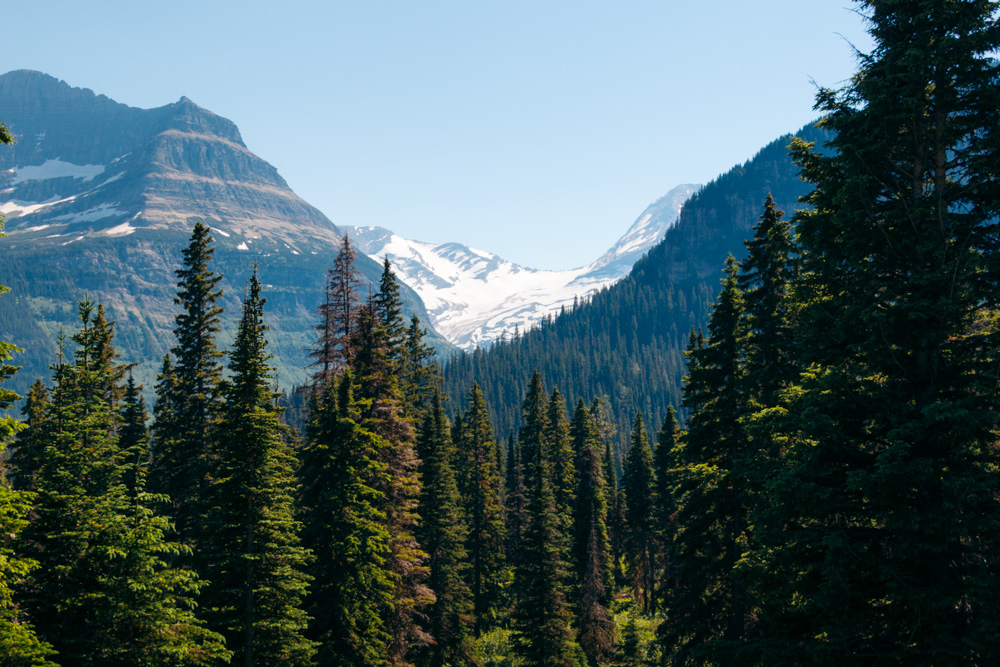
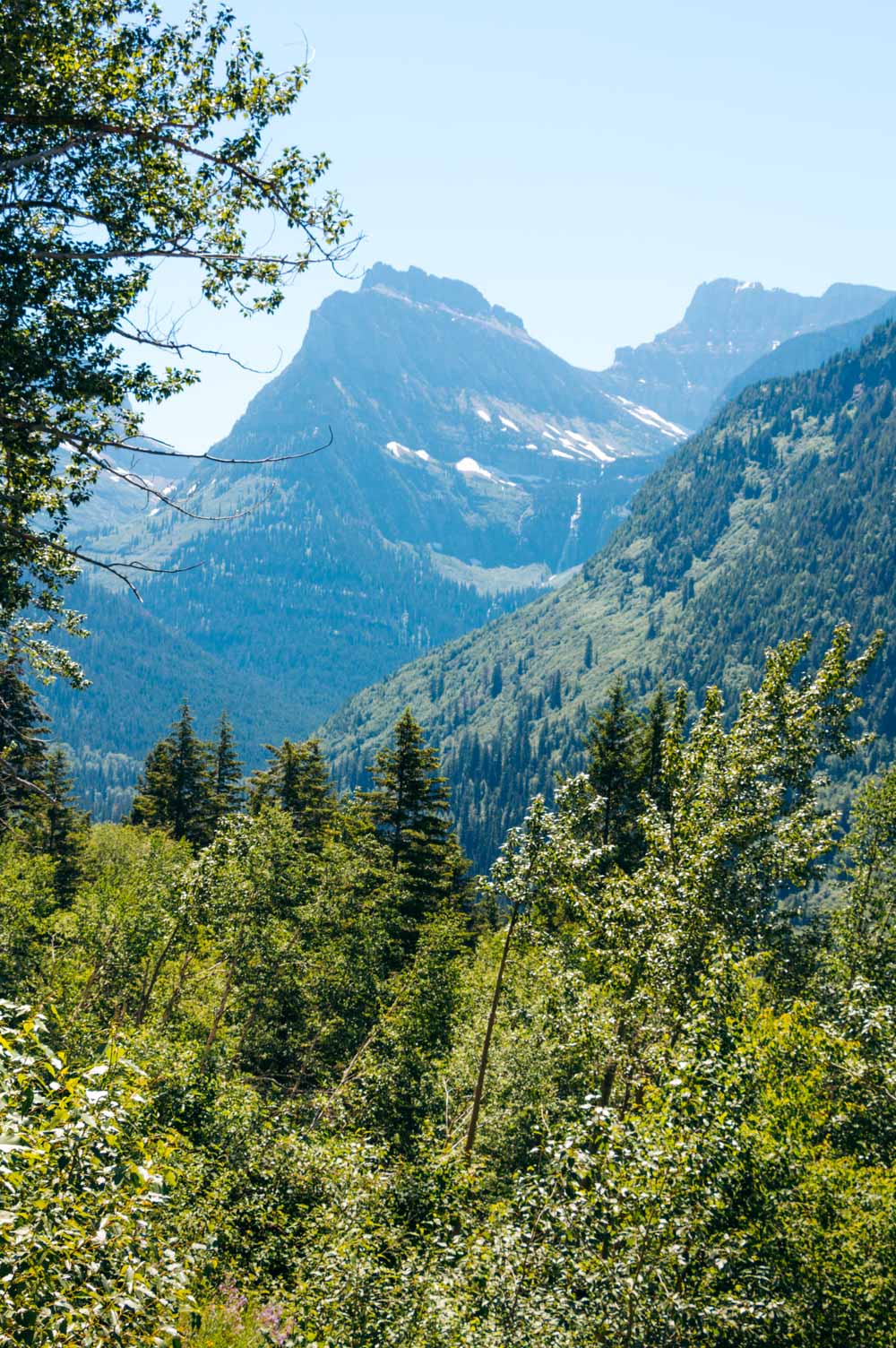
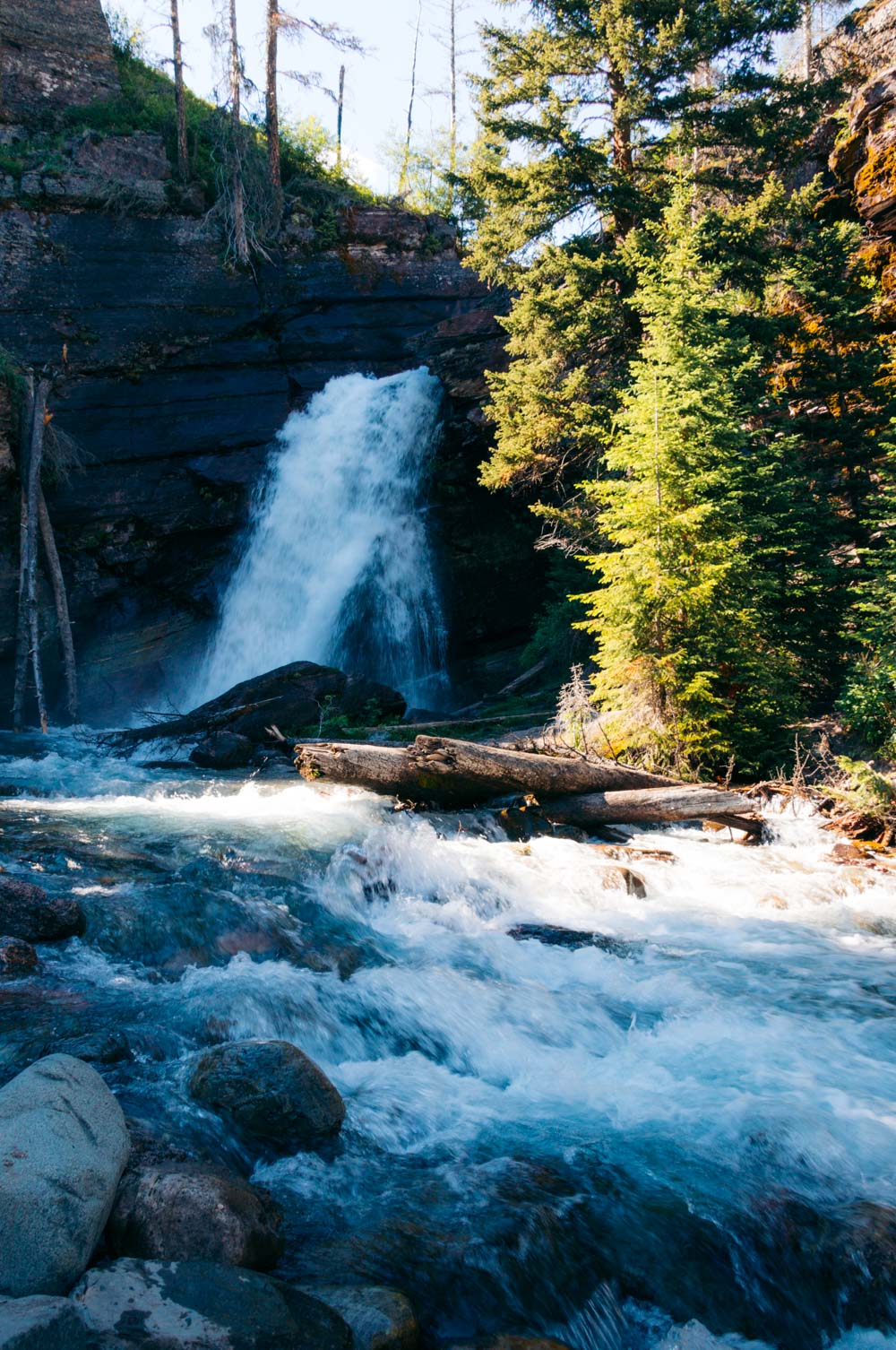
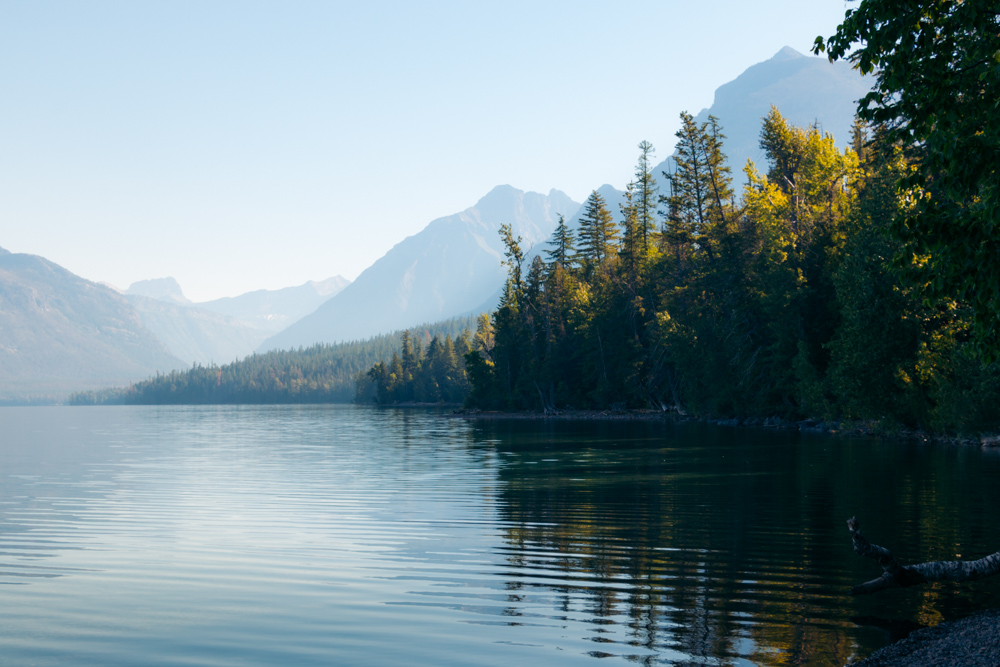
6. See a Glacier
While exploring Glacier National Park, you must visit or at least see… well, a glacier. The easiest place to admire the frozen snow atop the mountains is at the Jackson Glacier Overlook. Just travel along the Going-to-the-Sun Road until you see an unmissable sign to the observation point. Pull over and enjoy the view.
To visit the favorite glacier in Many Glacier, hike along the Grinnell Glacier Trail with outstanding views of quaint Grinnell Lake.
7. Explore Glacier National Park’s Waterfalls
Where to start here? If you visit Glacier National Park during the peak season, the waterfalls and cascading creeks greet you from near and far. A number of the gushing falls can be seen while traveling along the Going-to-the-Sun Road.
For a short hiking adventure, visit St. Mary and Virginia Falls, both sitting in East Glacier. The out and back path is 3.6 miles long. Need a longer trail to stretch your legs after traveling through Glacier National Park by car? Add Baring Falls to the above-mentioned waterfall duo for a nice, approximately 6-mile hike in East Glacier.
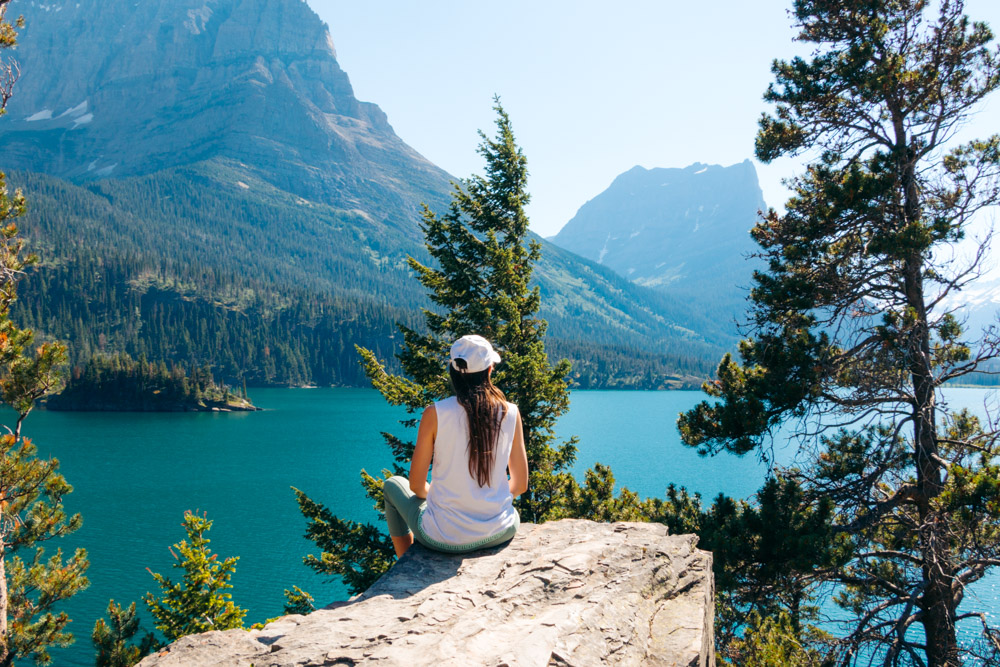
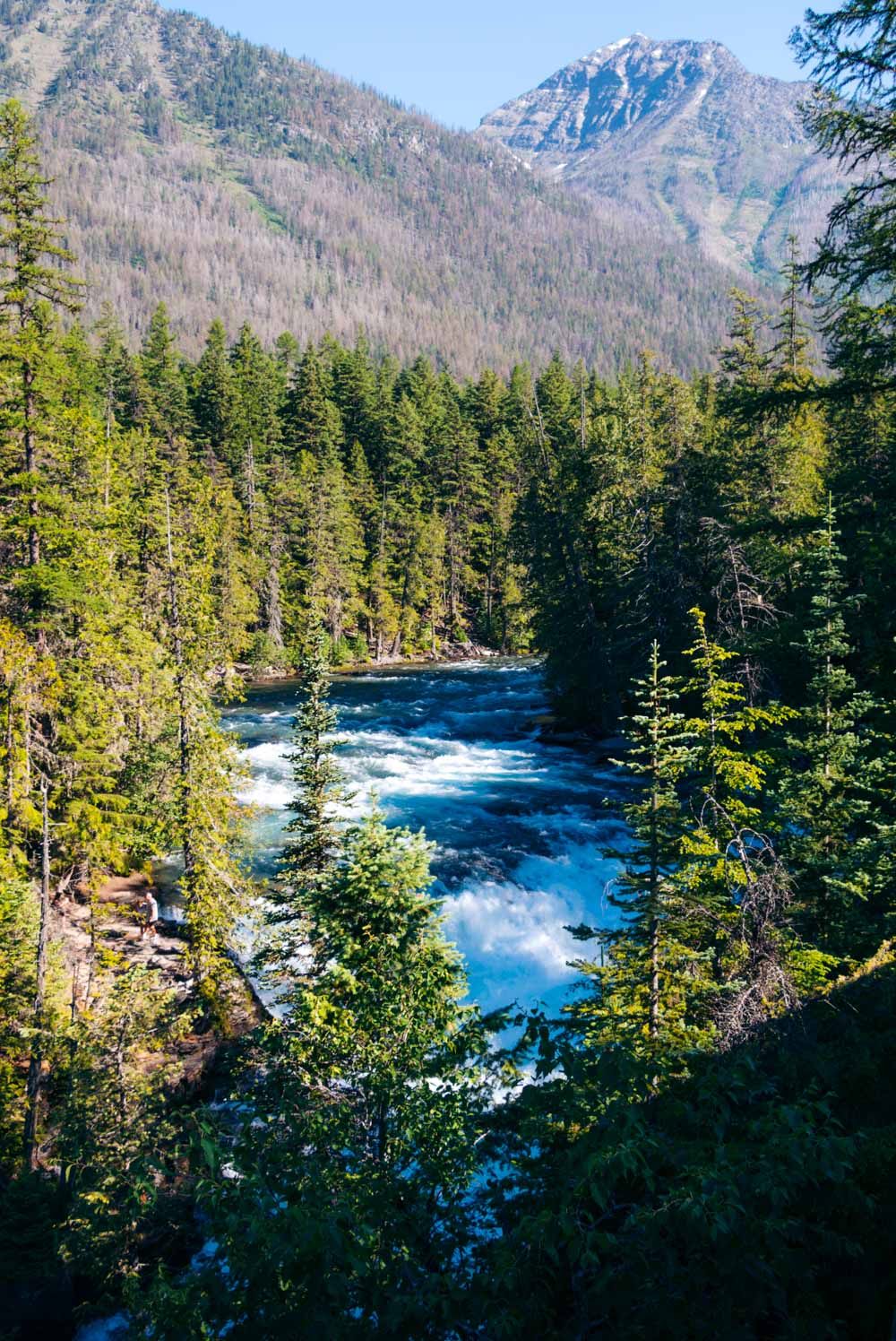
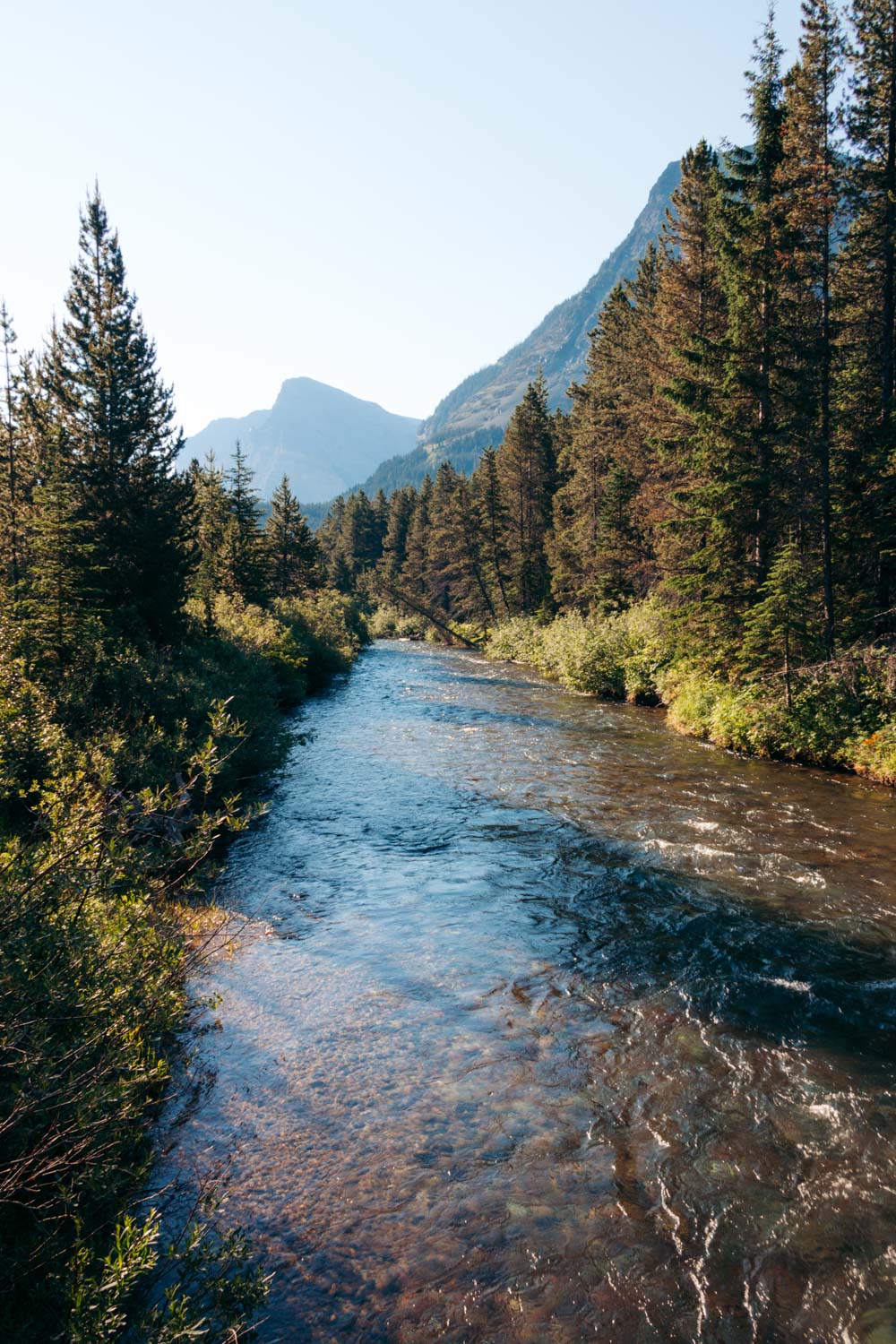
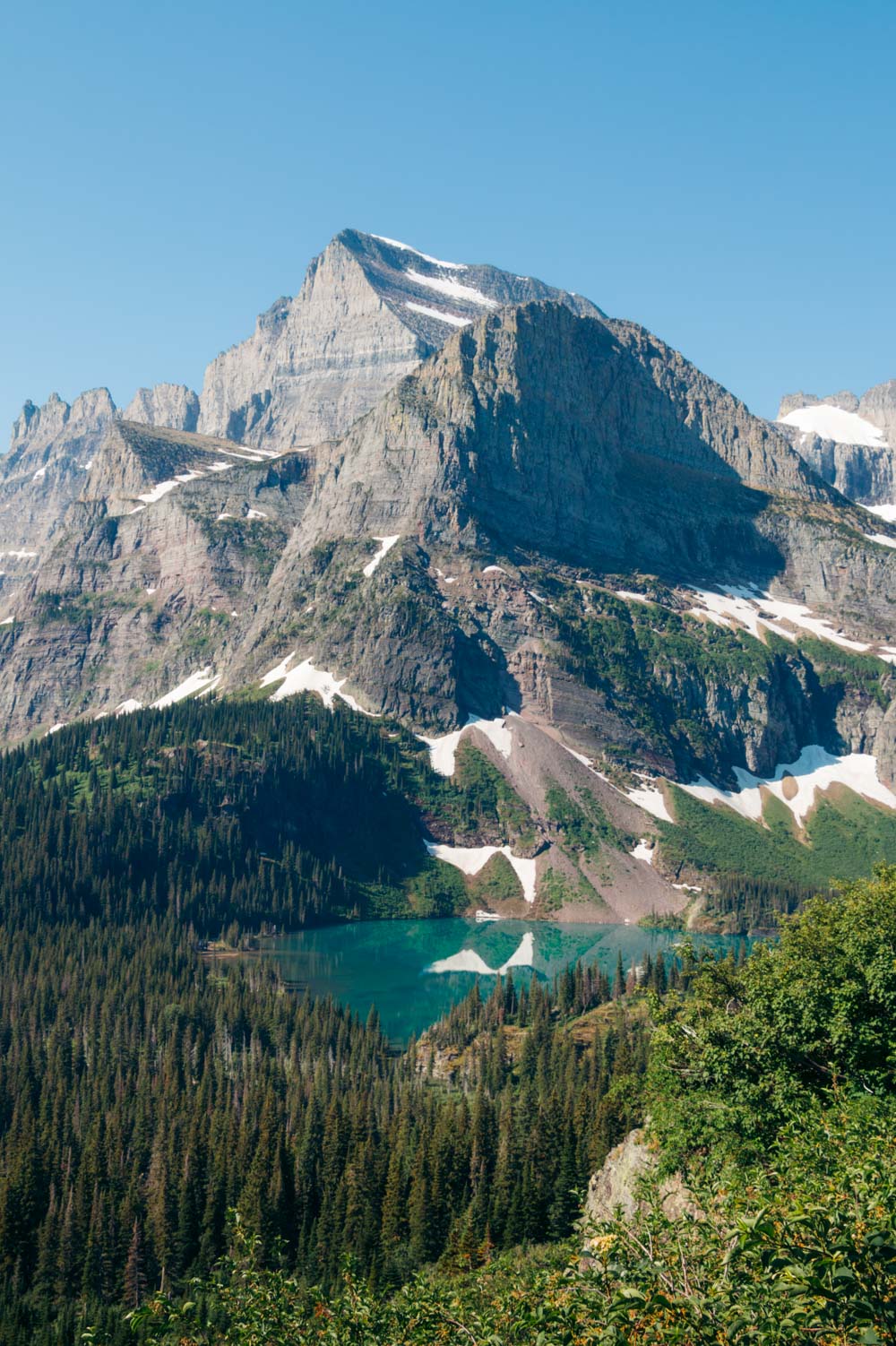
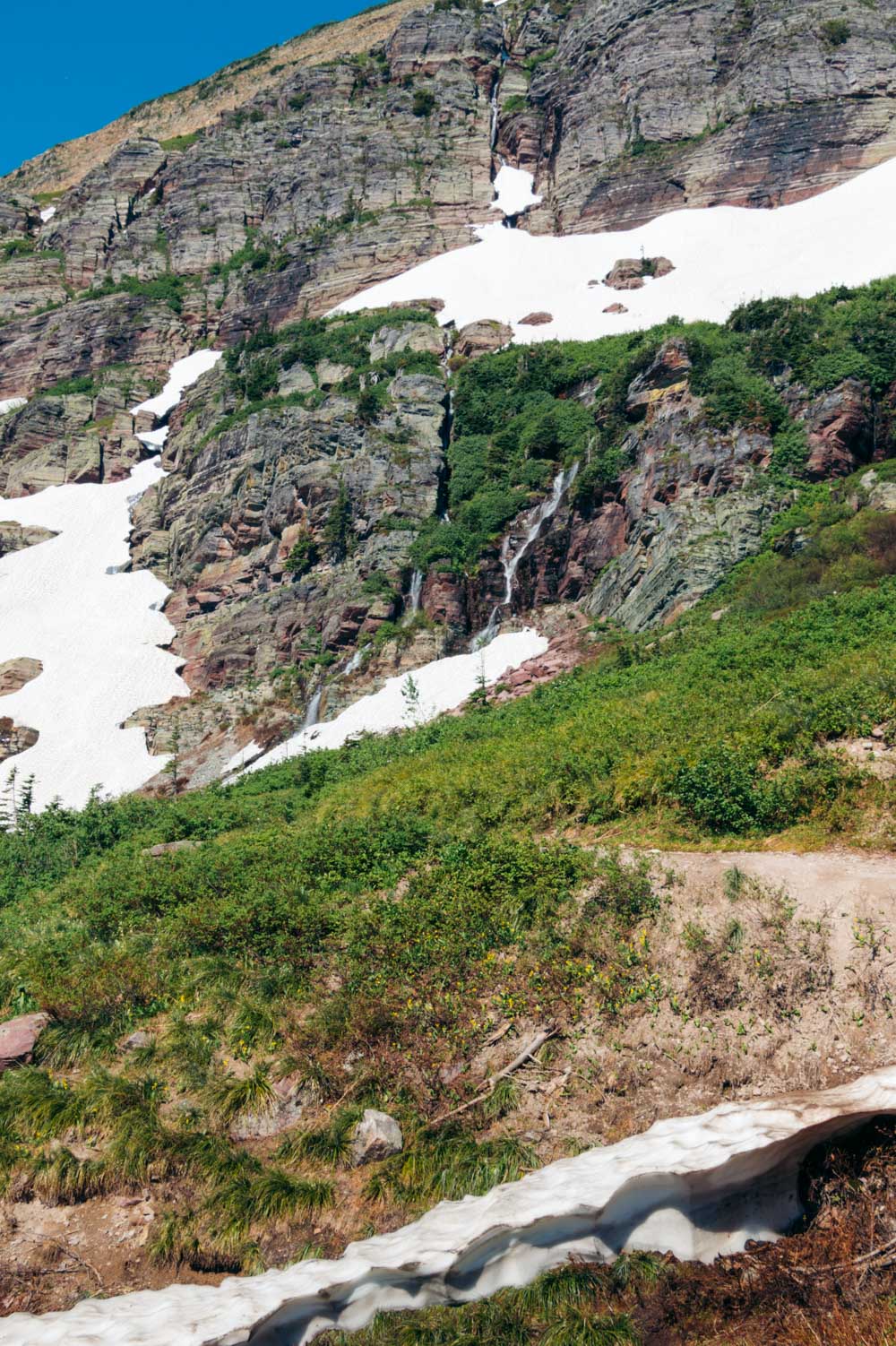
8. Visit St. Mary Lake in East Glacier
The second largest lake in Glacier National Park, St. Mary Lake is a dream destination to visit for all outdoor adventurers. Enticing with its aquamarine water, the place boasts some of the most panoramic vistas, a number of waterfalls, and photogenic Wild Goose Island.
9. Visit Many Glacier
In Many Glacier, you don’t need any specific destinations to feel like you’ve just been transported to a hilly region in Switzerland. The area is breathtaking. Packed with towering glaciers and pristine lakes, Many Glacier is often considered the number one place to visit in the park.
10. Visit Two Medicine, a Hidden Gem in Glacier National Park
Two Medicine kills two birds with one stone: it amazes with its natural beauty and allows you to explore the park away from the crowds. Often overlooked, this section of Glacier National Park is the biggest hidden gem to explore through and through. Some of the highlights of this area are Two Medicine Lake, Running Eagle Falls, and Aster Falls.
READ MORE: 10 Incredible Places not to Miss in Glacier National Park
Glacier National Park Guide: Map
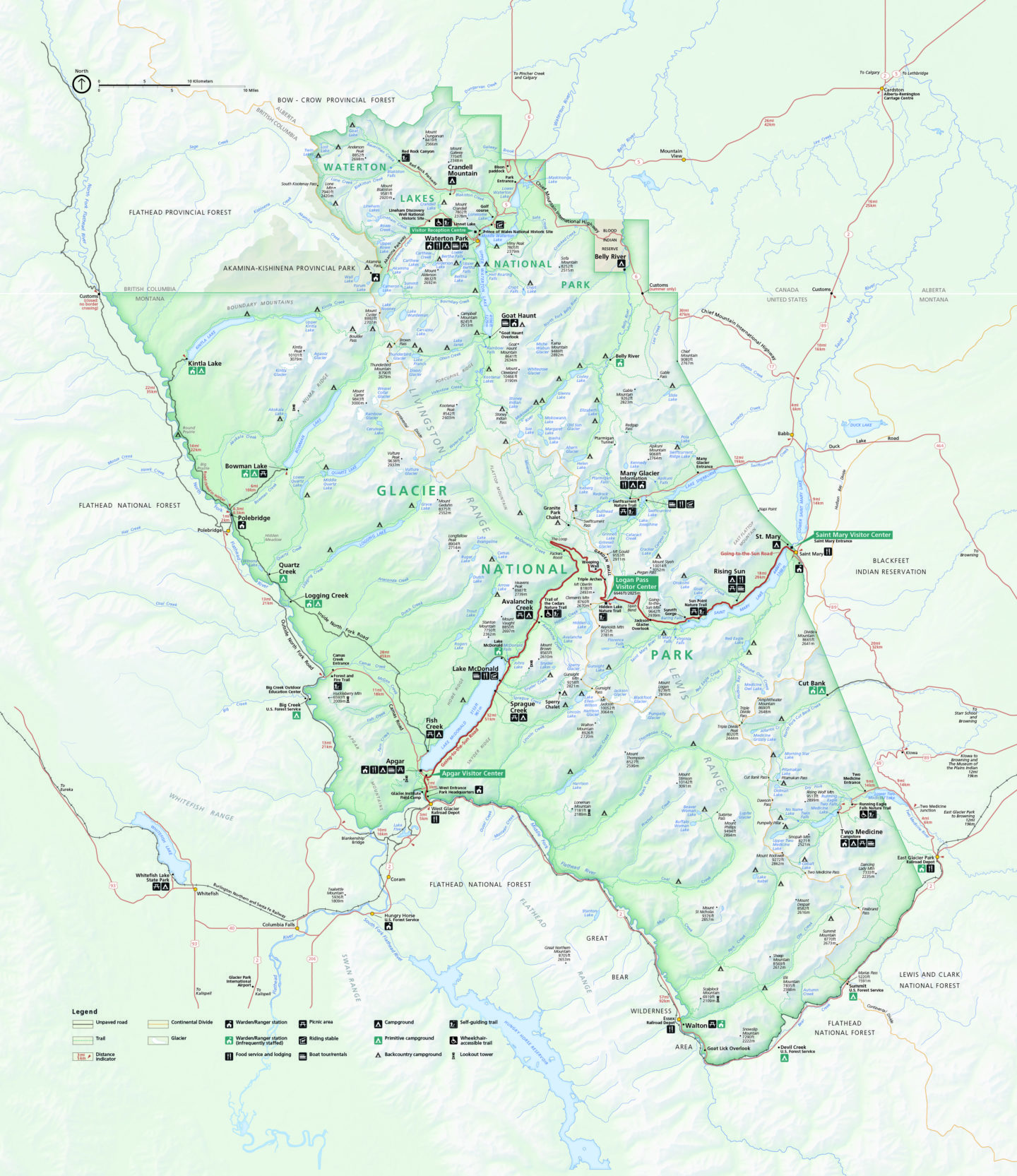
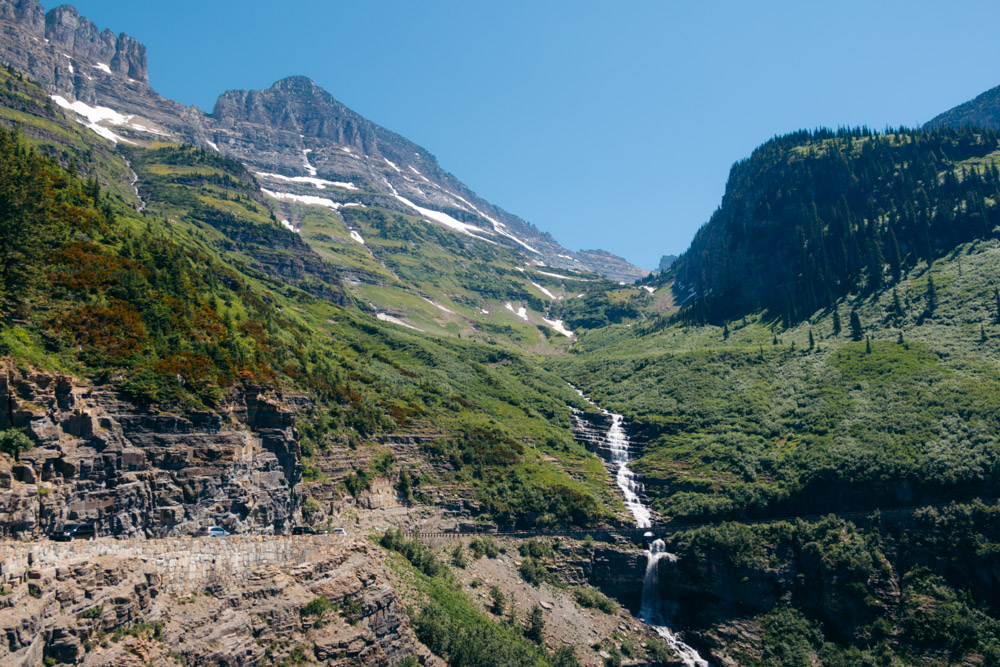
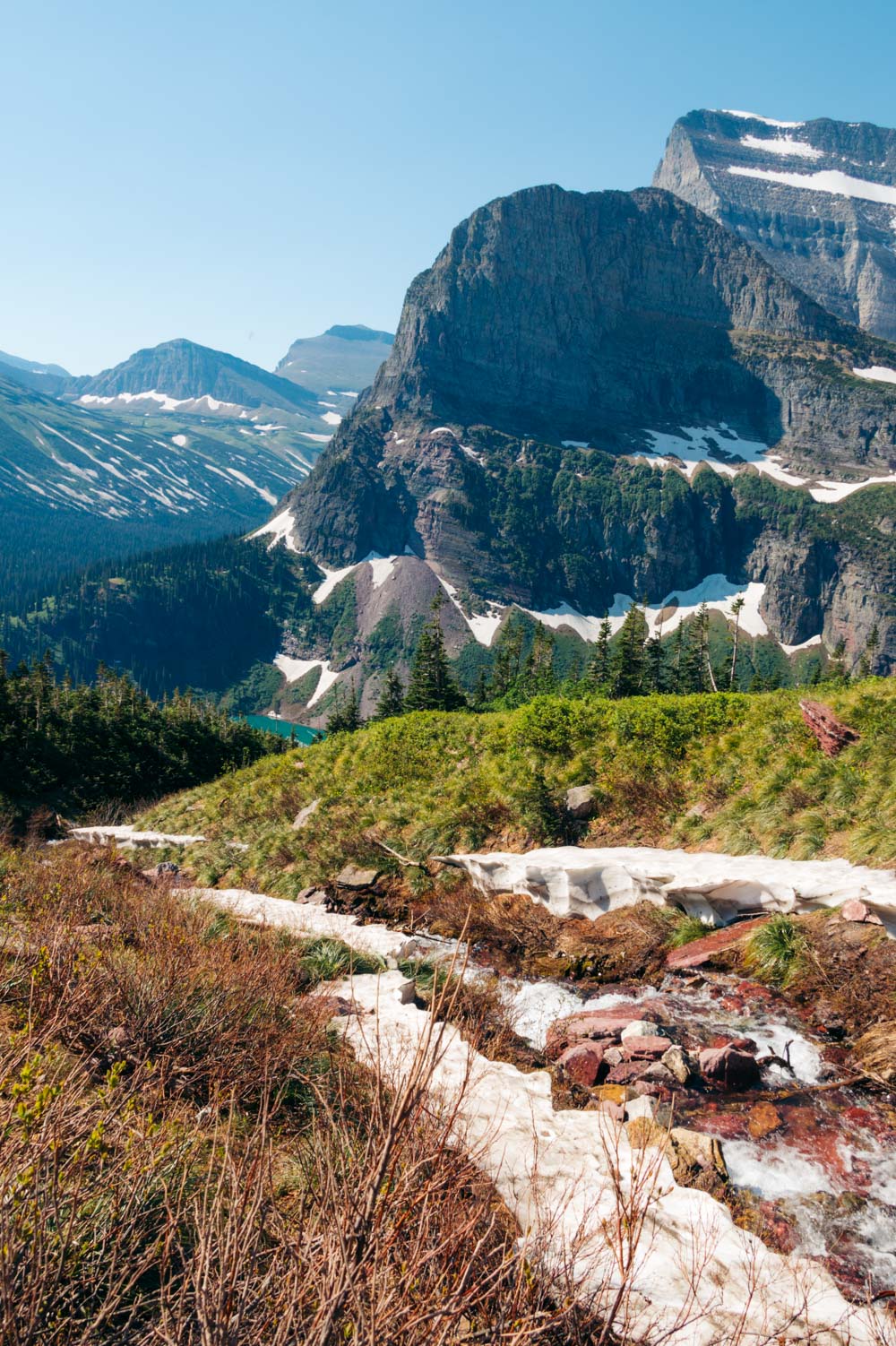
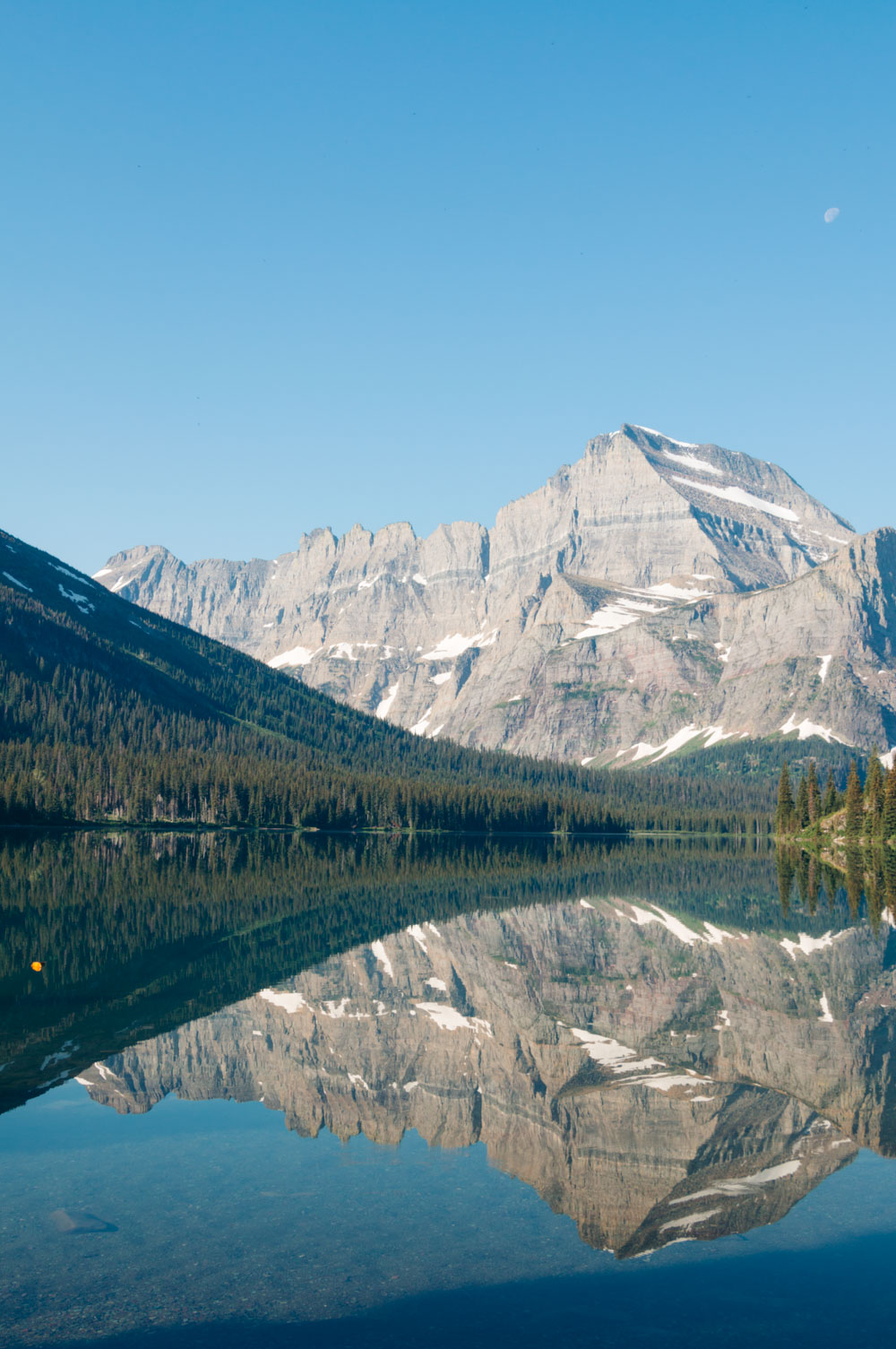
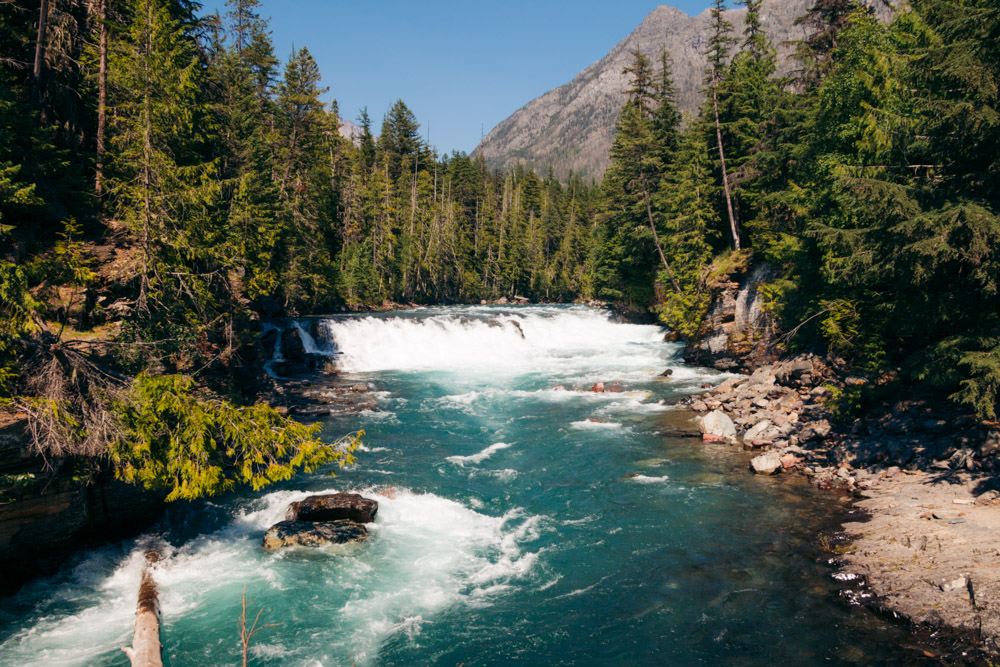
How Many Days Do You Need in Glacier National Park?
Ideally, you need at least 3 days to visit all major sections of Glacier National Park. Neighboring Waterton Lakes National Park asks for an additional day. So you look at a minimum 4 days for your visit to the Glacier National Park area.
Glacier National Park Travel Guide: 4-Day Itinerary
Day 1: Drive along the Entire Going-to-the-Sun Road
It takes approximately 2 hours to travel from the West Glacier Entrance to the St. Mary/East Glacier Entrance. While enjoying the scenic drive, make a few stops along the way to admire roadside waterfalls and hike to gorgeous alpine lakes. If you are driving from West Glacier, hike the Avalanche Lake Trail early in the morning. Head straight to Logan Pass afterwards and explore its alpine meadows while walking uphill to the Hidden Lake Overlook.
Sprinkle your evening itinerary with gushing waterfalls nestled along the shores of St. Mary Lake. You can hike to all three major waterfalls in this corner of Glacier (St. Mary Falls, Virginia Falls, and Baring Falls) or visit just one of them.
Day 2: Visit Many Glacier
The first long hike to do in Many Glacier is indisputably the Grinnell Glacier Trail. The 10.6-mile, round-trip hike takes anywhere from 3 to 5 hours to complete. Spend the rest of the day admiring the gorgeous views at Lake Josephine and Swiftcurrent Lake. Boating or kayaking is another great option to finish your day in Many Glacier.
Day 3: Escape the Crowds at Two Medicine
The two places you can spend the whole day in this section of Glacier National Park are Two Medicine Lake and Cobalt Lake. Apart from the gorgeous views unobstructed by huge crowds, go for a hike, spy on Glacier’s wildlife from a distance, or chase astounding waterfalls that dot the area.
TIP: Learn how to protect yourself from bears in the wild before visiting Glacier National Park. While looking so adorable in pictures, these wild beasts are dangerous in their natural habitat.
Day 4: Explore the Canadian Side
Cross the border and spend a day in Waterton Lakes National Park. If you have more time, drive farther north to Banff National Park, Jasper National Park, and Yoho National Park.
Note: In reality, each of Glacier National Park’s sections require at least two days. So you can take it a little slowly and spend 4 days exploring the Going-to-the-Sun Road and Many Glacier. We did just that, and I still feel like we barely scratched the surface and left plenty of natural attractions to explore during our next trip to Glacier National Park.
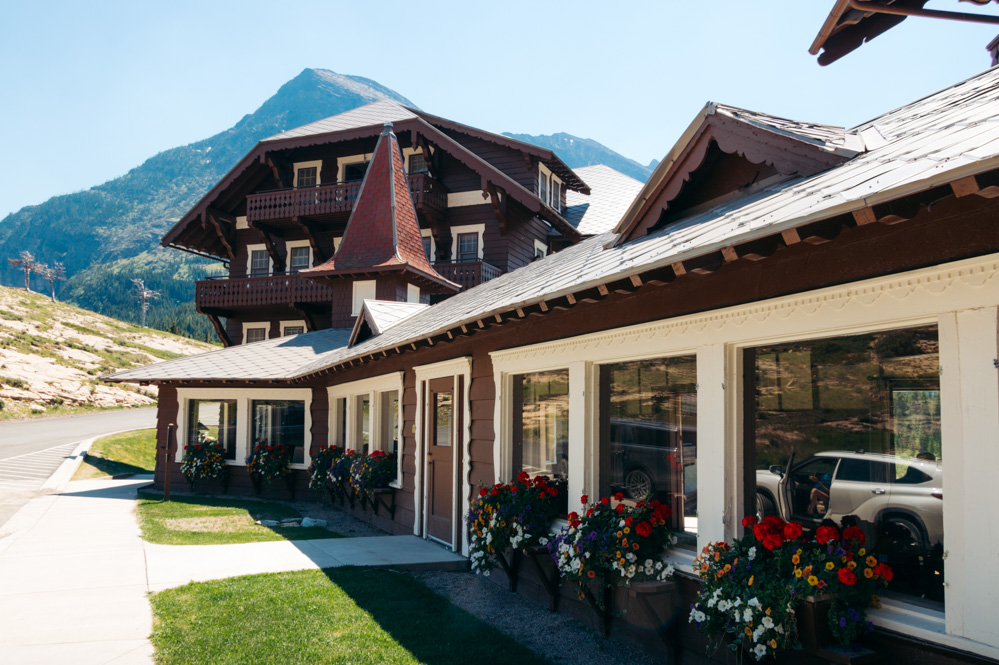
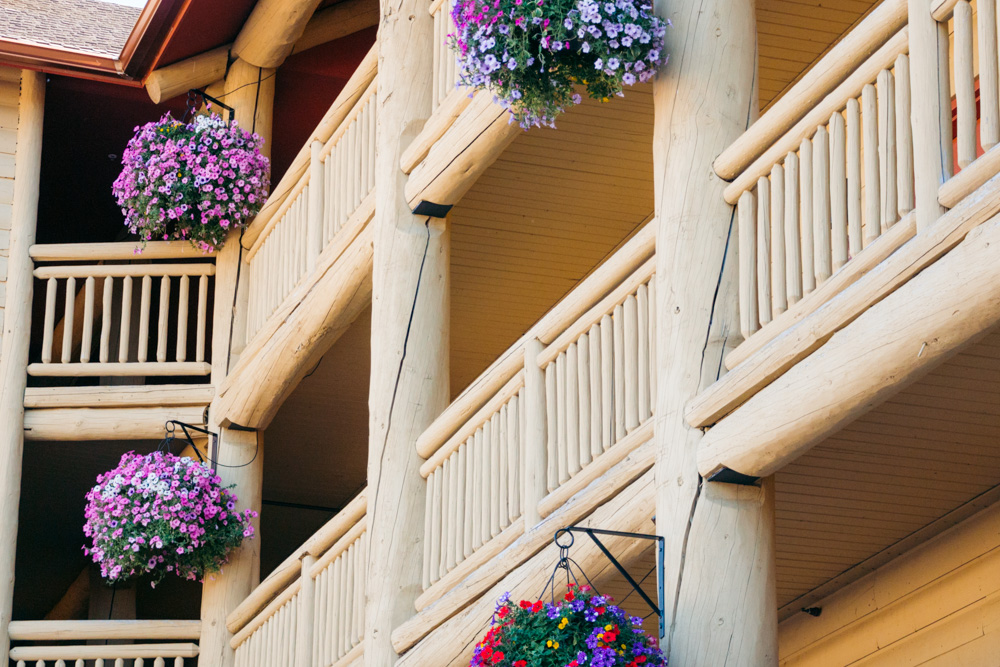
Glacier National Park Guide: Where to Stay
One thing is sure. You want to stay in Glacier National Park or as close as possible to it, especially when you travel during the summer season when the influx of visitors makes getting around the area quite problematic.
The park features 13 campgrounds spread out across different sections. The most popular campsites are nestled along the Going-to-the-Sun Road. Here you can stay at either the Apgar, Sprague Creek, Avalanche, Rising Sun, and St. Mary campgrounds. Make sure to reserve your spot in advance as the sites are usually fully booked during the busy season.
Despite a sense of complete immersion into nature, camping is a favorite pastime of only a small number of people visiting Glacier National Park. Luckily, the area has several hotels and lodges ranging from basic rooms to rustic cabins and glamorous accommodations. Consider the following lodgings when you visit Glacier National Park next time.
- Many Glacier Hotel. The Many Glacier Hotel is the largest lodge in Glacier National Park. The place sits on the eastern shore of Swiftcurrent Lake in Many Glacier.
- Lake McDonald Lodge. The Lake McDonald Lodge offers 82 rustic, but comfortable rooms and a convenient location near some of the biggest landmarks in West Glacier.
- Swiftcurrent Motor Inn. The Switfcurrent Motor Inn is another popular place to stay at in Many Glacier.
- Apgar Village Lodge. Located in West Glacier, the Apgar Village Lodge is your first choice in the Lake McDonald area.
Accommodation Outside Glacier National Park
If driving is not an issue, consider the following places to stay near Glacier National Park.
- The Lodge and Resort at Lake Mary Ronan. If you want to visit more jewels of Montana, such as Lake Mary Ronan, on your way to or from Glacier National Park, be sure to stop at the Lodge and Resort at Lake Mary Ronan. The place sits approximately 1 hour 20 minutes away from the national park and breathes peace and tranquility in the best Montana style.
- St. Mary Village Great Bear Lodge. Nestled right outside the St.Mary Entrance, the St. Mary Village Great Bear Lodge offers rustic rooms and a great location for the Going-to-the-Sun Road. Furthermore, it’s one of the best places to stay at if you plan to visit the Many Glacier and Two Medicine areas the following day.
- Travelodge by Wyndham Kalispell. Travelodge by Wyndham Kalispell suits budget travelers. The hotel is located approximately 40 minutes away from West Glacier. Thanks to its airport, the closest to Glacier National Park, Kalispell is the best place to stay in on your first or last day in the area.
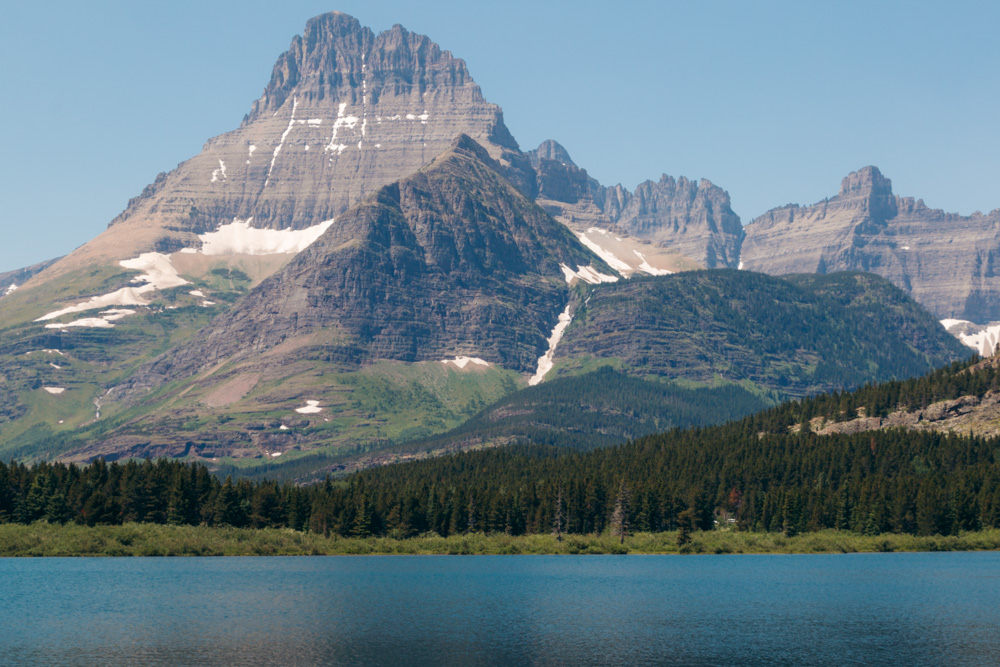
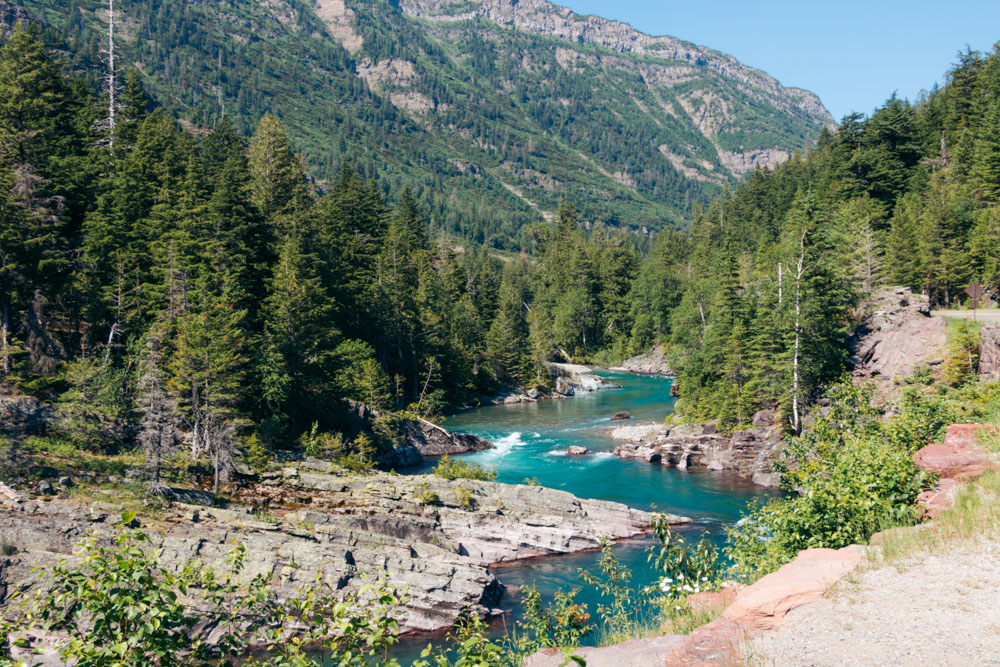
Glacier National Park Guide: Places to Eat
Food choices are rather limited in Glacier National Park. The best way to ensure that you can replenish your energy with nourishing food is to visit a grocery store near Glacier and stock up on some snacks and dry foods, such as bread, nut butters, and fresh produce. For an occasional treat and hot meal, visit the following cafes and restaurants nestled in Glacier National Park.
- Eddie’s Cafe. Located inside the Apgar Village Lodge, the Eddie’s Cafe treats tired hikers to delicious burritos, wraps, burgers, and salads. Its Thai wrap is always the first choice for vegan visitors.
- Russell’s Fireside Dining Room. The Lake McDonald Lodge is home to the Russell’s Fireside Dining Room with its classic breakfast options, hearty burgers and cheeseburgers, salads, and yummy desserts. For vegan and vegetarian visitors of Glacier National Park, the restaurant prepares fresh brown rice and quinoa bowls.
- Heidi’s. For a quick grab-and-go meal, visit Heidi’s, located inside the Many Glacier Hotel. Here you can find hot and cold snacks, such as pre-made sandwiches, breakfast pizzas, and drinks.
- Two Dog Flats Grill. Classic American menu awaits the guests of the Two Dog Flats Gill, located at the Rising Sun Motor Inn & Cabins. Visit this humble spot in East Glacier to savor its signature soups or build your own burger.
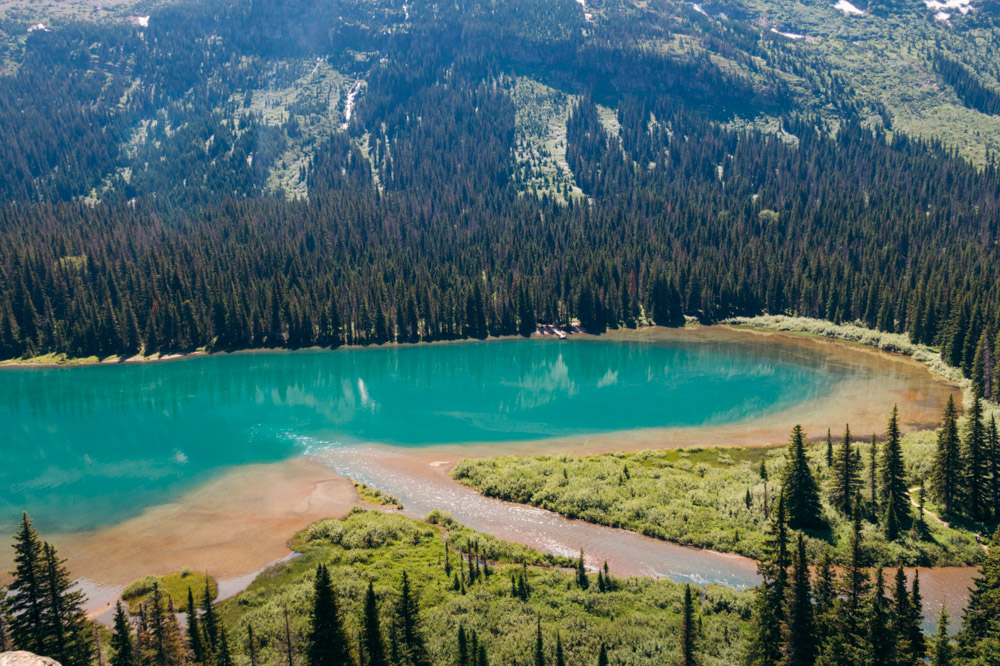
Visit Waterton Lakes National Park on a Day Trip from Glacier National Park
For the majority of Montana’s guests, a visit to Glacier National Park often includes a short trip across the border to Waterton Lakes National Park. Nestled in the northern Rocky Mountains along the American and Canadian border, the two parks form Waterton-Glacier International Peace Park.
Officially established in 1995, this protected area is home to the remarkable snow-capped mountains, alpine lakes, and abundant glacier-fed creeks. Over 300 terrestrial species of animals dwell here, occasionally surprising human visitors with their company.
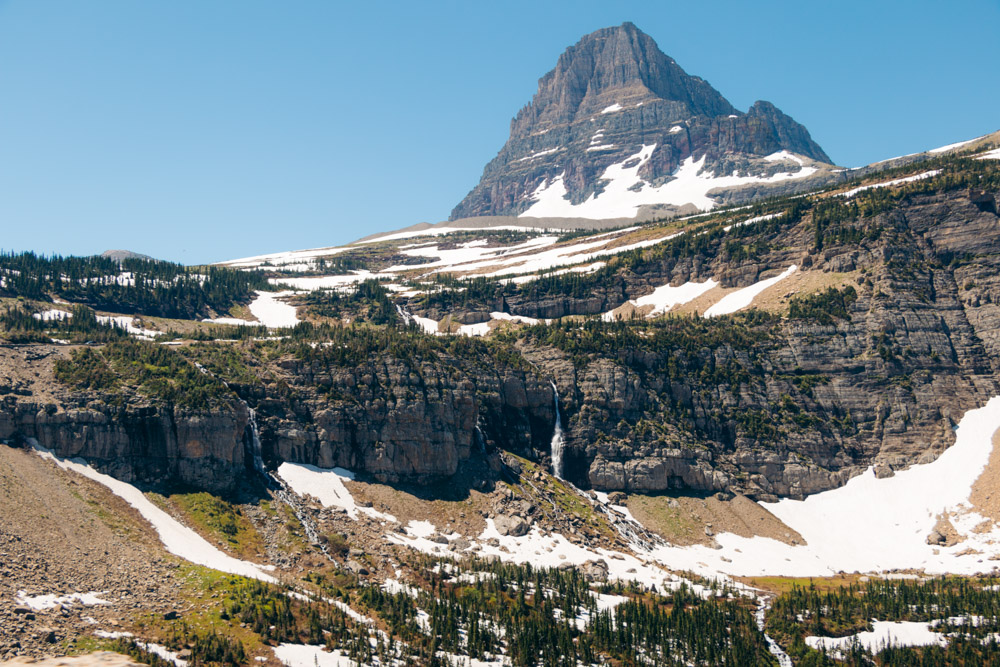
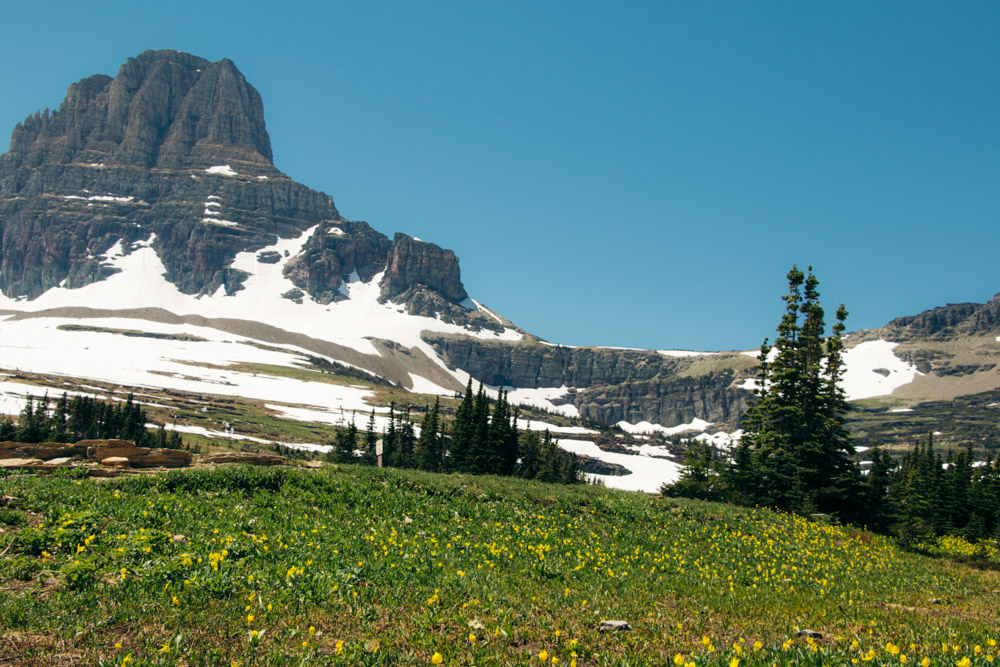
Glacier National Park Guide: Admission and Fees
Visit Glacier National Park by Car
$35 is a standard fee to visit Glacier National Park by car. The entrance pass is valid for 7 consecutive days per one vehicle.
Glacier National Park by Bicycle or on Foot.
The visitors traveling on foot or by bicycles must pay $20 upon arrival. It’s called a single entry fee.
Visit Glacier National Park by Motorcycle
$30 is an entrance fee for those who visit Glacier by motorcycle.
Visit Glacier National Park: Annual Pass
If you plan to visit Glacier National Park several times a year, consider purchasing an annual pass, which costs $70.
Visit Glacier with America the Beautiful Pass
The best option, though, is to get the America the Beautiful Pass. You pay $80 and visit all national parks and monuments any time within a year of your purchase.
TIP: The entrance fee is required to visit Glacier National Park. If the entrance station is not staffed, follow instructions available at the gate for self-payment. The holders of the unexpired America the Beautiful Pass can proceed to the park immediately.
Read More
- Road trip to Glacier National Park: Spokane to Glacier Road Trip: 5-Day Adventure
